Vermont is an incredible state, home to mountains, cities, farms, lakes, and rivers. People come to Vermont to ski, hike, eat, explore, study, and much more.
Birding is a popular pastime in Vermont, especially because there are so many different kinds of birds that live in or visit the state.
In addition to woodpeckers, songbirds, birds of prey, and other kinds of birds, you’ll also find plenty of ducks in Vermont. With so many natural waterways, it makes sense that we would see so many ducks here.
We’ve put together a list of 26 different kinds of ducks, including scoters, mergansers, and scaup. Using this list, you can learn to identify many of Vermont’s ducks.
How to Identify Vermont’s Ducks
In order to become an experienced duck identifier, you’ll need to learn the basics of recognizing ducks in the wild. From a distance, many ducks can look similar, but there are often telltale signs, even beyond what they look like.
For example, there are many brown female ducks in Vermont, but not all of them are present in Vermont at the same time. Because ducks are migratory, if you know when a specific duck is present in the state, that knowledge can help you differentiate one duck from another.
These are the key identifying features of any duck:
- Silhouette (shape)
- Size (including height, weight, length, and wingspan)
- Habitat (which may change seasonally)
- Unique behaviors
- Migration patterns
- Coloring & patterns
One important thing to know is that many male ducks change their appearance completely between the breeding and non-breeding season. Additionally, most ducks are sexually dimorphic, so females and males don’t look similar to one another.
Dabbling Ducks & Diving Ducks
One of the behaviors that differentiate ducks from one another is how they forage for food. Each kind of duck will be categorized as either a diving duck or a dabbling duck.
Diving ducks submerge themselves completely under the water to get food from the bottom of the lakebed, riverbed, or waterway. They may dive a few feet or, in the case of Long-Tailed Ducks, up to 200 feet.
Dabbling ducks turn themselves over and dip their heads under the water, but never submerge completely. Their tails are often seen “dabbling” out of the water, poking up and floating along.
Dabbling ducks are generally found in shallower waters because they need to be able to reach the ground beneath the surface.
In our list of 26 ducks in Vermont, we’ve identified each one as either a dabbler or a diver. Let’s take a look at the many, many ducks you have the opportunity to see here in Vermont!
American Black Duck (Dabbling Duck)
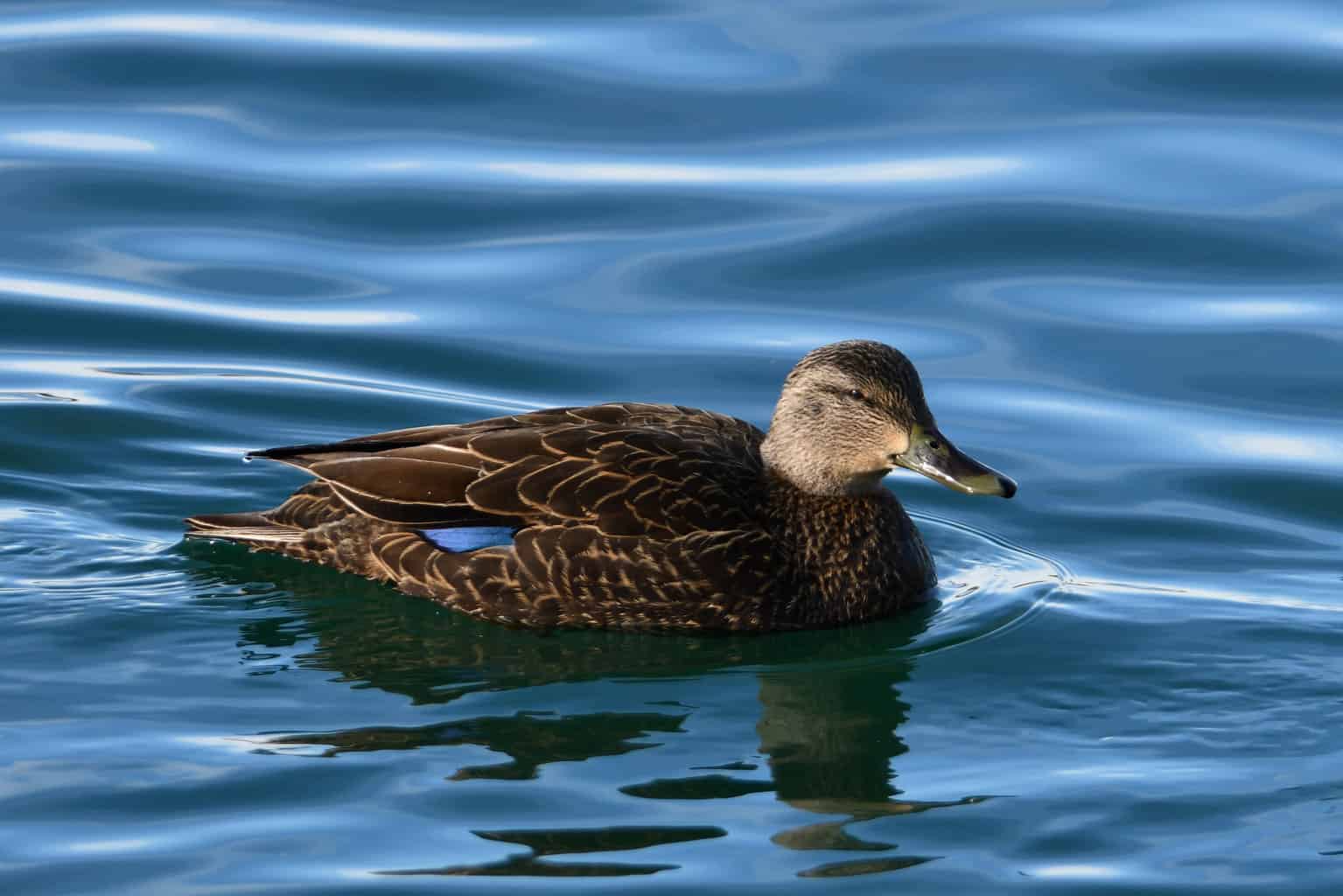
- Anas rubripes
- Length: 21.3-23.2 inches
- Weight: 25.4-57.9 ounces
- Wingspan: 34.6-37.4 inches
While they are technically sexually dimorphic, male and female American Black Ducks look more similar to one another than many other ducks.
Males are darker brown than females, who are a bit lighter. The female’s bill is green, whereas the male’s bill is greenish-yellow.
Both sexes have white under their wings, and they also both have a purplish-blue speculum. The speculum is a rectangular band of color on the secondary wings of a bird. Many ducks, but not all, have this stripe, though the colors vary significantly.
American Black Ducks breed exclusively in the eastern half of the US. They also spend the winter in New England, as well as the Midwest and the Southeast US. They live comfortably in both saltwater and freshwater habitats.
This means that they are year-round residents of Vermont and are most commonly sighted between October and April.
American Wigeon (Dabbling Duck)

- Mareca Americana
- Length: 16.5 – 23.2 in (42 – 59 cm)
- Weight: 19.1 – 46.9 oz (540 – 1330 g)
- Wingspan: 33.1 in (84 cm)
American Wigeons are medium-sized dabbling ducks who build their nests on the ground, near the water. Males have gray bodies with green stripes on the sides of their heads and a white cap. They have the nickname “baldplate” because of the appearance of baldness.
Female American Wigeons have brown bodies and gray-brown heads. Males and females alike have pale bills.
American Wigeons breed in the western half of Canada and then migrate to the US south and east coast. They migrate through Vermont on their way to and from their summer and winter territories.
American Wigeons eat a diet of insects, aquatic invertebrates, and aquatic plants. They can be found in both saltwater and freshwater habitats. In general, they prefer secluded waterways like ponds and lakes.
In the spring, their migratory groups are fairly small, but in the fall, they’ll migrate in groups that number in the hundreds.
Barrow’s Goldeneye (Diving Duck)
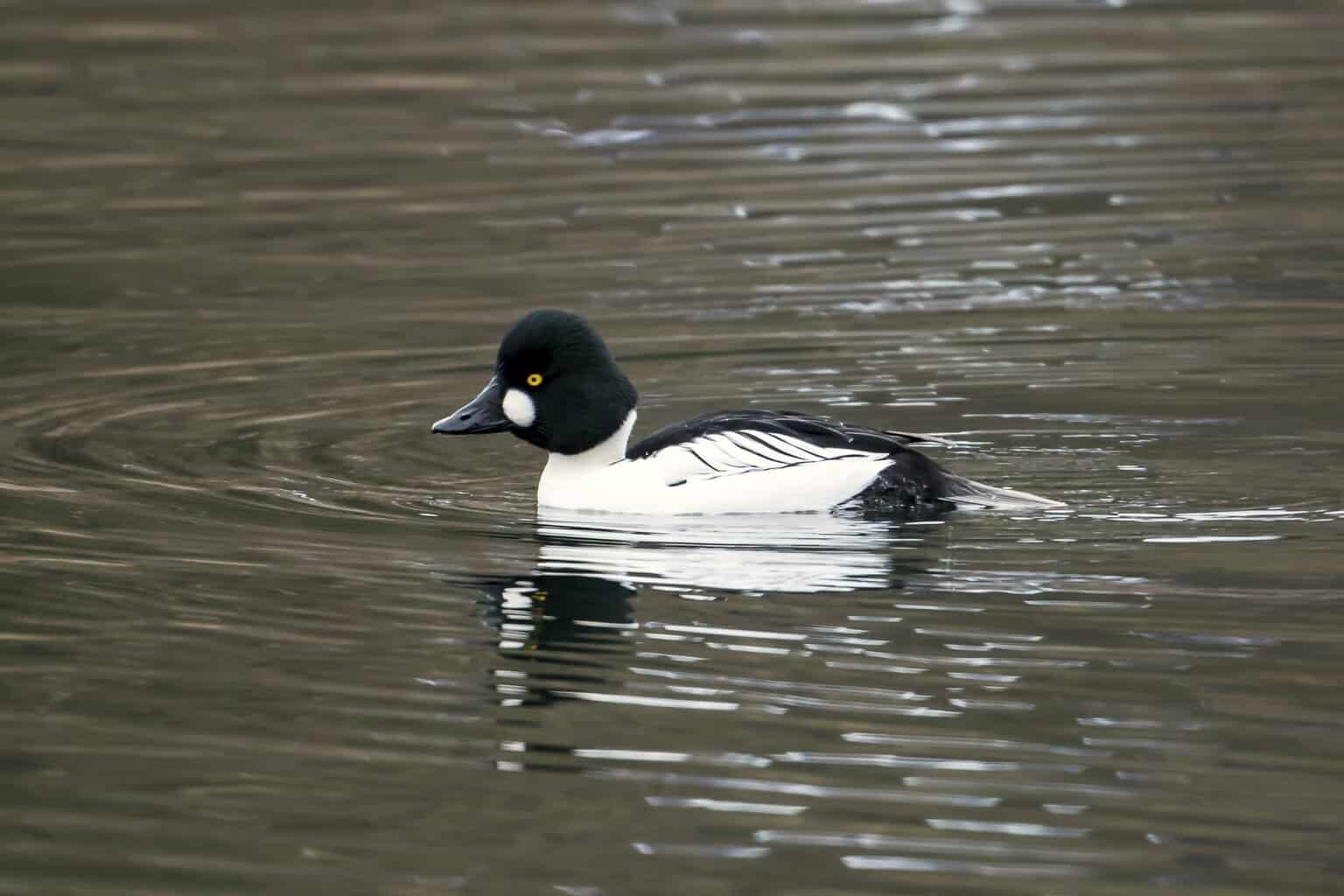
- Bucephala islandica
- Length: 16 – 20 in (41 – 51 cm)
- Weight: 38.4 oz (1088 g)
- Wingspan: 30 – 32 in (76 – 81 cm)
Barrow’s Goldeneyes are more commonly associated with the Pacific Coast, but some do live on the New England Coast. They are only spotted in Vermont during the winter months, typically in small groups.
As cavity dwellers, Barrow’s Goldeneyes prefer to live in abandoned woodpecker nests. That said, they will live in nests and trees if they need to.
Their diet is made up almost entirely of insects, so they avoid waters that are home to insect-eating fish. There is too much competition!
The male Barrow’s Goldeneye has a purple, almost-black head and a white crescent on his cheek. His bill is black, and he has a series of white square-ish spots on his black wings.
The female is dark gray, with a dark brown head and a white collar around her neck. Her bill is orangeish-yellow.
Both sexes have bright, yellow-gold eyes, just like the Common Goldeneye.
Black Scoter (Diving Duck)
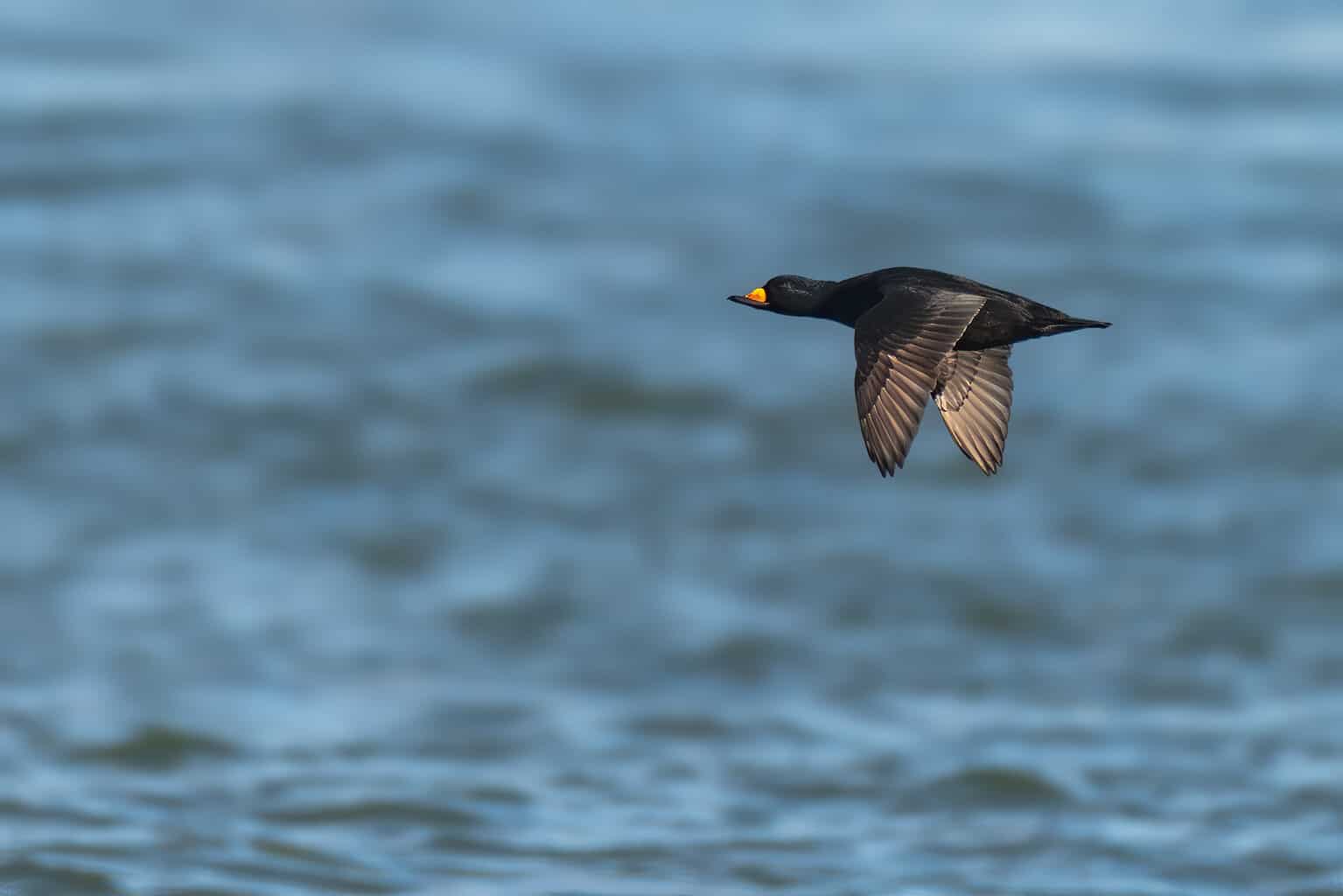
- Melanitta Americana
- Length: 127 – 21 in (43 – 53 cm)
- Weight: 387.4 oz (1088 g)
- Wingspan: 30 – 35 in (76 – 89 cm)
Every year, Black Scoters migrate through Vermont, arriving on Lake Champlain in October and November. They winter on both North American oceanic coasts and breed mostly in Northern Quebec.
Male Black Scoters are black and have a bright orange bulb at the base of the bill. Females, on the other hand, are brown. They also have a dark brown crown and a black bill that lacks that signature knob shape.
Black Scoters flock in groups that number in the thousands, often with other Scoters. They eat a lot of saltwater shellfish, mollusks, and shrimp. When they’re in freshwater, they eat fish eggs and larvae as well as aquatic plants.
Blue-Winged Teal Duck (Dabbling Duck)
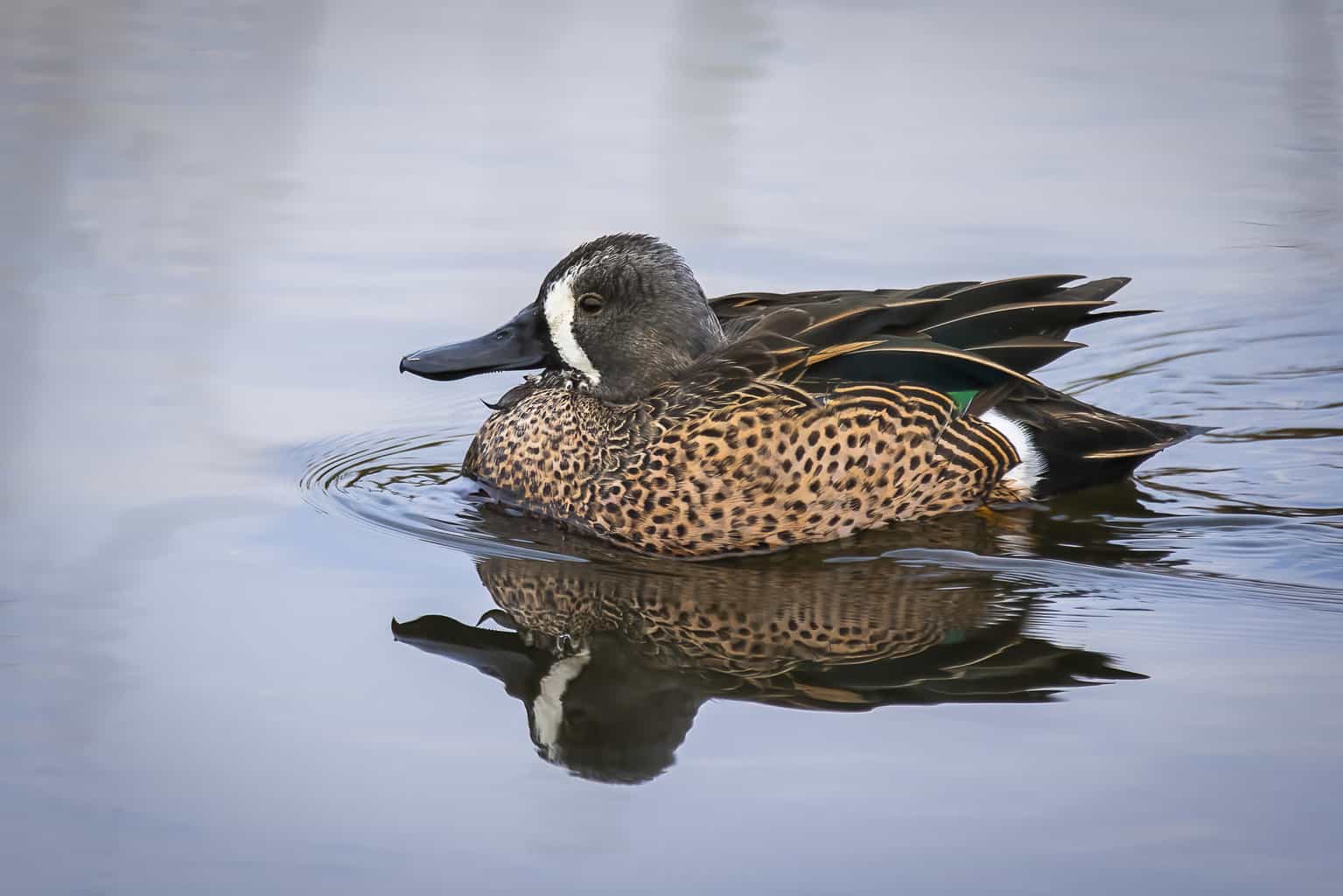
- Spatula discors
- Length: 15 – 17 in (38 – 43 cm)
- Weight: 19.18 oz (544 g)
- Wingspan: 23 -31 in (58 – 79 cm)
Blue-Winged Teal Ducks are not common in Vermont, but there are confirmed sightings every year, especially around Lake Champlain and near the northern New Hampshire/Vermont border.
Male Blue-Winged Teal Ducks are small, brown ducks with spots and a blue-gray head. The male’s facial markings include a white crescent in front of his eyes. He also has a blue shoulder patch and green speculum.
Females lack the distinguishing crescent shape, but they do have similar spots to the male.
Regrettably, Blue-Winged Teal Ducks have the highest mortality rates of any other dabbling ducks. Additionally, researchers are currently learning more about why Blue-Winged Teals may play a large role in the spreading of avian influenza to birds that live on commercial poultry farms.
Bufflehead (Diving Duck)
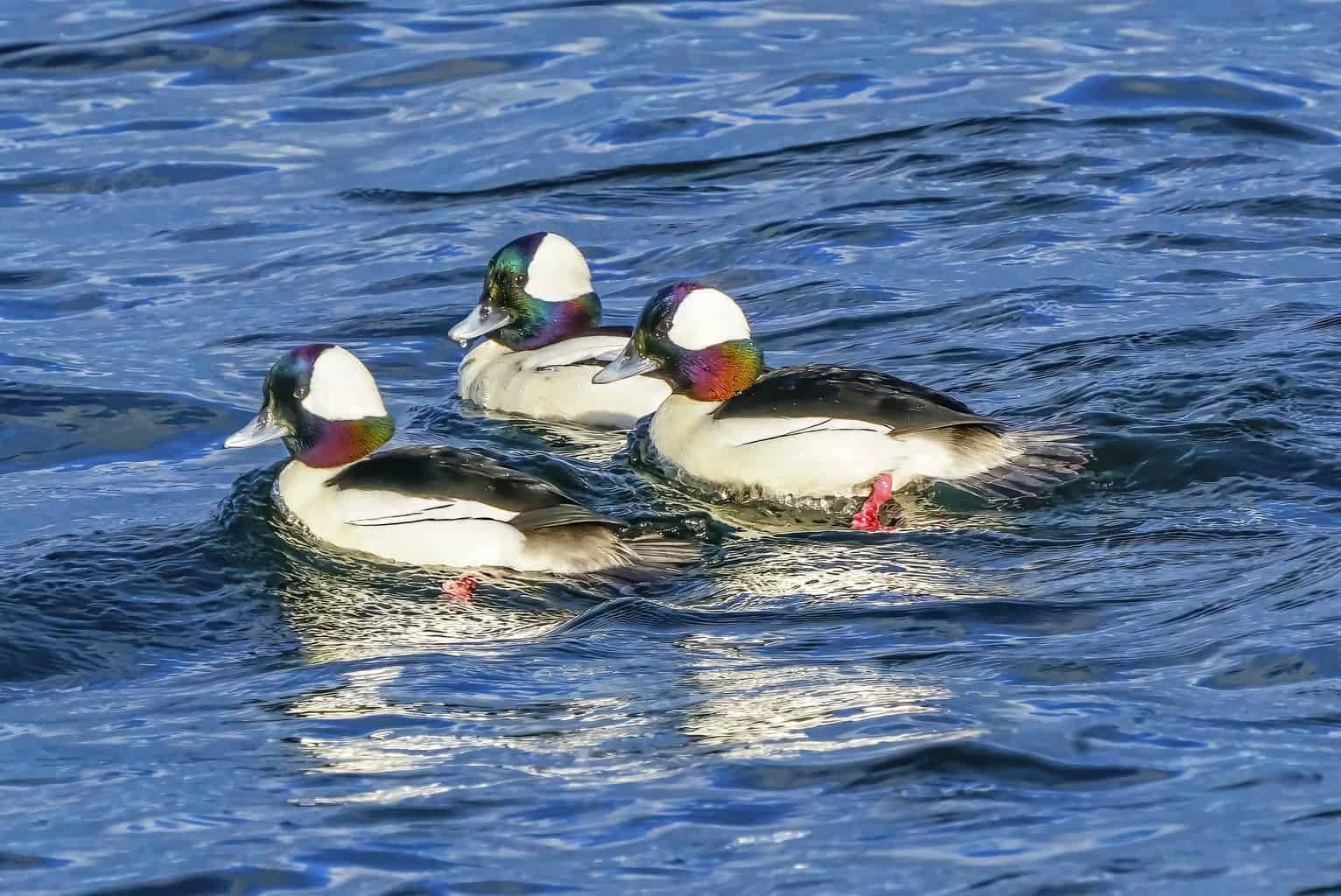
- Bucephala albeola
- Length: 13 – 16 in (33 – 41 cm)
- Weight: 21.16 oz (600 g)
- Wingspan: 20 – 24 in (51-61 cm)
Male Buffleheads have such a fascinating, color-block-style appearance. They have fluffy, round heads that are iridescent green and purple with a huge, almost fan-shaped block of white that goes from the back of the eyes and around the head.
Females have the same rounded head, but their bodies are gray and black, and they have a dark brown head coloring with a white patch on each cheek.
The name “Bufflehead” is derived from the “buffalo” shape of the head.
These ducks live in abandoned tree cavities for their breeding and non-breeding season. They are usually seen in Vermont during their migration, so many of them don’t stay for long and likely won’t build a cavity nest.
However, some pairs will stay in New England for the winter. You may want to build a nest box near their preferred habitat of mixed coniferous and deciduous forests. Not all ducks enjoy nest boxes, but Buffleheads are often inclined to make nest boxes their home.
Canvasback (Diving Duck)
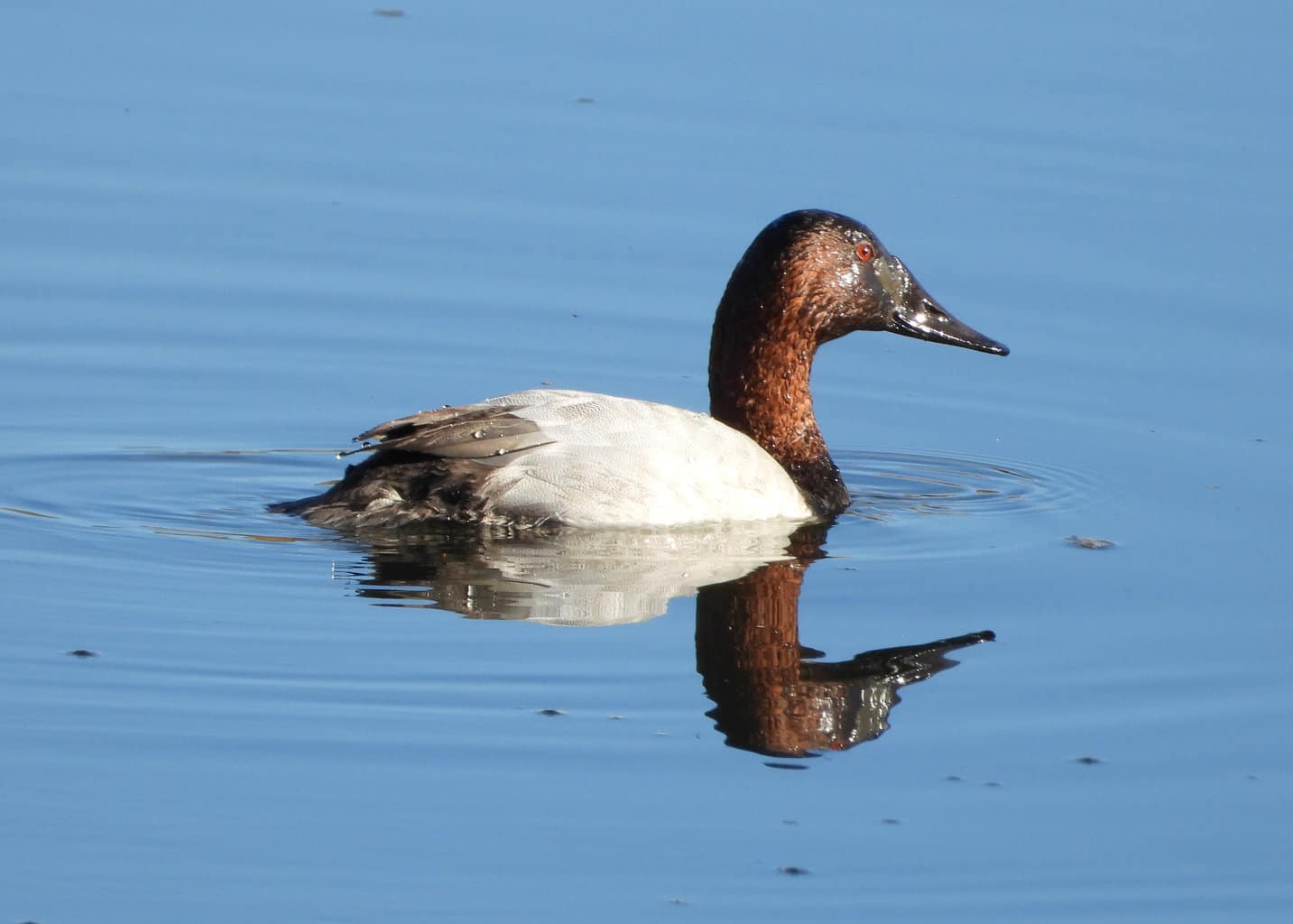
- Aythya valisineria
- Length: 19 – 24 in (48 – 61 cm)
- Weight: 58.48 oz (1657 g)
- Wingspan: 28 – 36 in (71 – 91 cm)
Canvasbacks are rare winter residents in Vermont, and you’re more likely to see them as they migrate from western Canada to the east coast of the United States.
They have a noticeable slope to their forehead, as well as a large, broad bill. The male’s head is dark coppery-brown. His chest is black, his body is gray, and he has red eyes.
Females look similar to males, but their coloring is plainer. They have dark black eyes instead of red eyes.
Because Canvasbacks are such large ducks, they have to have very durable nests. They are North America’s largest diving ducks, and their nests are made from strong aquatic grasses like cattails and sedges.
Common Goldeneye (Diving Duck)
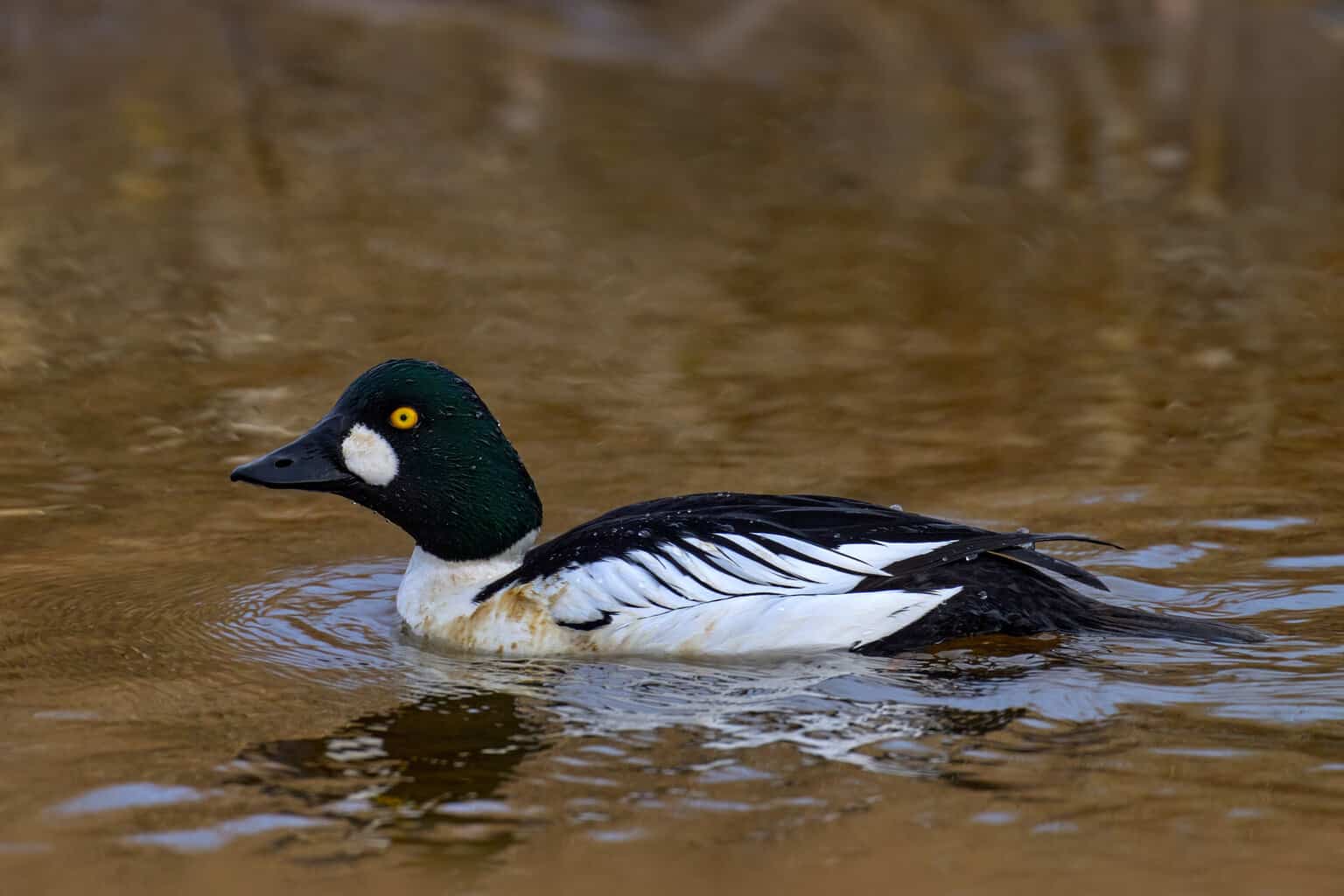
- Bucephala clangula
- Length: 16-20 inches
- Weight: Approximately 1.8 pounds
- Wingspan: 30.3-32.7 inches
Common Goldeneyes have a lot in common with Barrow’s Goldeneyes, but there are some key differences.
First, their similarities: Males are primarily black and white, and females are mostly brown. Regardless of sex, they all have golden-yellow eyes.
Now, their differences: the male Common Goldeneye’s head is more of an iridescent green instead of purple, he also has much more white on his wings, and his bill is longer than the stubby bill of the Common Goldeneye.
Barrow’s and Common Goldeneye females are even more similar to one another. Their patterning is almost identical, so it’s harder to spot the differences. You’ll notice that the female Common Goldeneye has a yellow-tipped bill, as opposed to an entirely yellowish-green bill. Her head is also lighter brown that the Barrow’s.
Common Goldeneyes breed throughout Canada and spread out across most of the US for the winter months. They are winter residents in Vermont, typically present between November and April. Because Vermont is so far north in their winter territory, it’s possible to see some of them year-round.
They are found on large lakes and rivers during the winter. For the Common Goldeneyes that stay in the state for the summer, you may notice that they are prone to fighting among themselves. This is even true of females who are raising their young.
Sometimes, in the hubbub of a fight between females, ducklings will get separated from their own mother and end up joining a new brood, which is called a creche.
Common Merganser (Diving Duck)
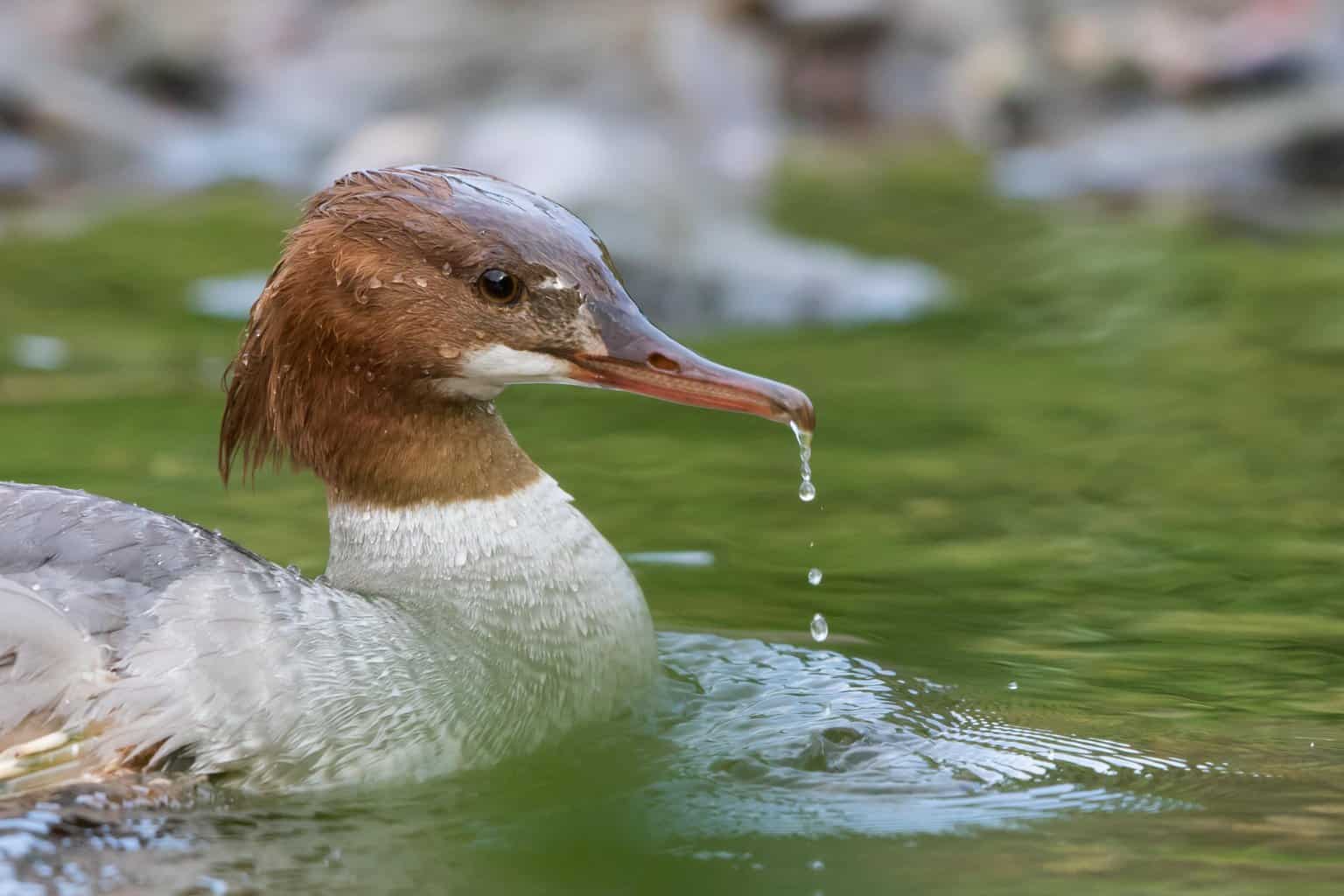
- Mergus merganser
- Length: 22 – 27 in (56 – 69 cm)
- Weight: 60.8 oz (1723 g)
- Wingspan: 31 – 37 in (79 – 94 cm)
Common Mergansers stand out from other ducks, thanks to the attention-grabbing crest of the female.
She has a white breast, a gray belly, and a gray back. Her cinnamon-red head and neck are a stark contrast to her pale body. Her crest is shaggy in appearance.
Males have a dark, iridescent green head with a bright red bill and black eyes. The rest of his body is white underneath and black on top.
Both sexes have a strong bill with a serrated edge, which allows them to rip apart the fish that they catch in the freshwater lakes and rivers where they live and hunt.
Their diet is made up of fish as well as aquatic insects, mollusks, worms, and crustaceans. They also eat frogs and small mammals. They will eat aquatic plants, too.
They are year-round residents of Vermont, where they nest in tree cavities that are close to the water. They will accept nesting boxes and crags as nesting spots if empty cavities are unavailable.
Gadwall (Dabbling Duck)
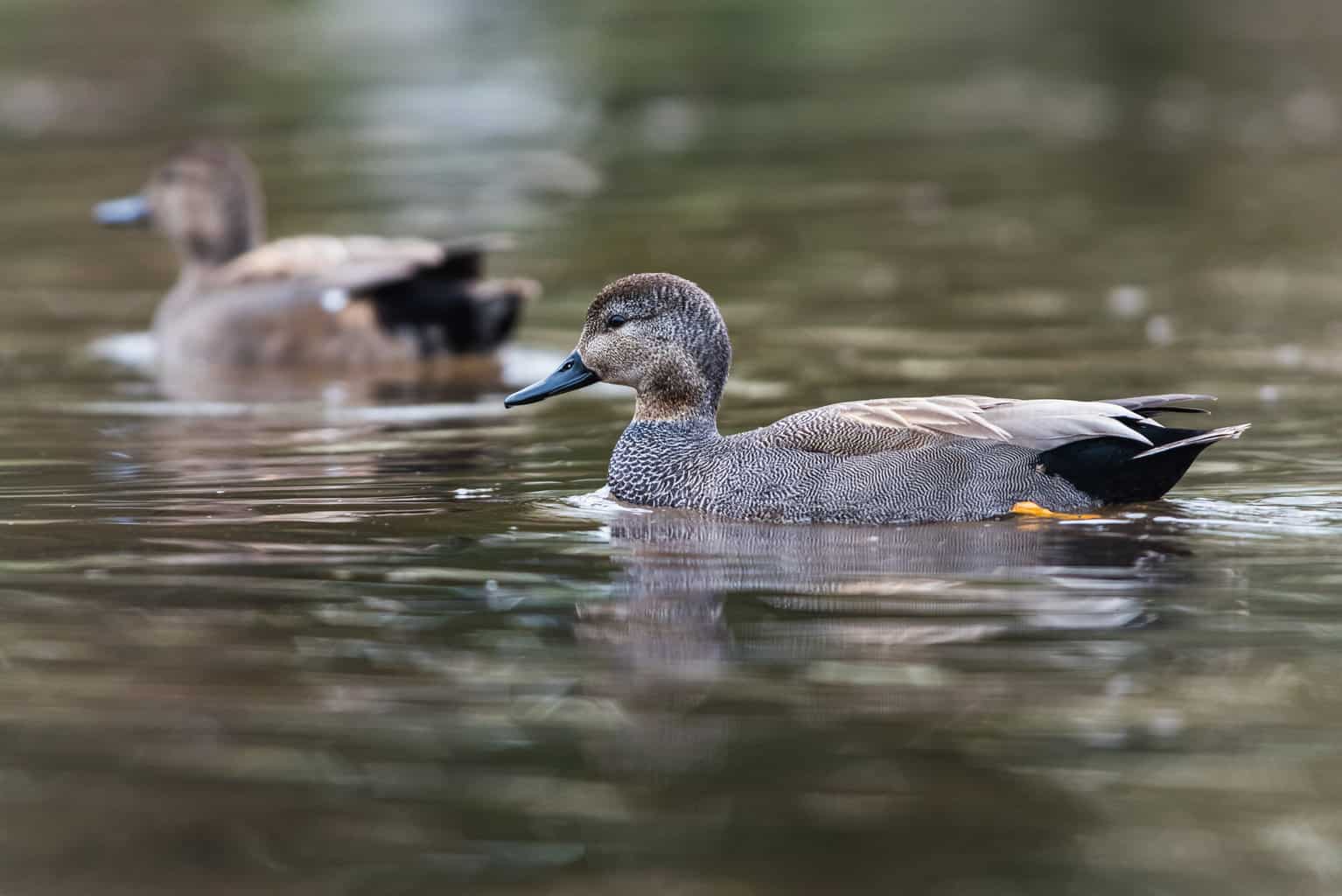
- Mareca strepera
- Length: 19 – 23 in (48 – 58 cm)
- Weight: 35.27 oz (1000 g)
- Wingspan: 31 – 36 in (79 – 91 cm)
Gadwall are incredibly common ducks. In fact, they are the third most frequently hunted duck in the US, following the Mallard and Green-Winged teal.
Many ducks on this list spend their breeding season in Canada, and some Gadwall do live in Canada for the summer. However, the Gadwall’s primary breeding territory is in the central region of the Southwest United States.
They are common migratory visitors throughout Vermont as they travel to the New England coast for the winter. In the far north, specifically in the Champlain Valley, Gadwall stick around for the breeding season, raising their babies in marshy wetlands.
Male Gadwall have grayish-brown bodies with a black spot on the tail. Females have dark and light brown patches over most of their bodies.
Both males and females have some white markings on their wings, but they’re not particularly noticeable – especially from a distance.
If you’re newer to identifying ducks, it may be easier to rule out other ducks before determining that you’re watching one or more Gadwall.
During the winter, Gadwall like saltwater marshes and city ponds and parks. They feel safest where there are lots of aquatic grasses that grow right up to the water’s edge. Their unremarkable coloring helps them to camouflage incredibly well among these reeds and grasses.
Camouflage is one of their best defenses against predators and hunters. Because humans hunt Gadwall so frequently, this species is especially wary of people.
Greater Scaup (Diving Duck)
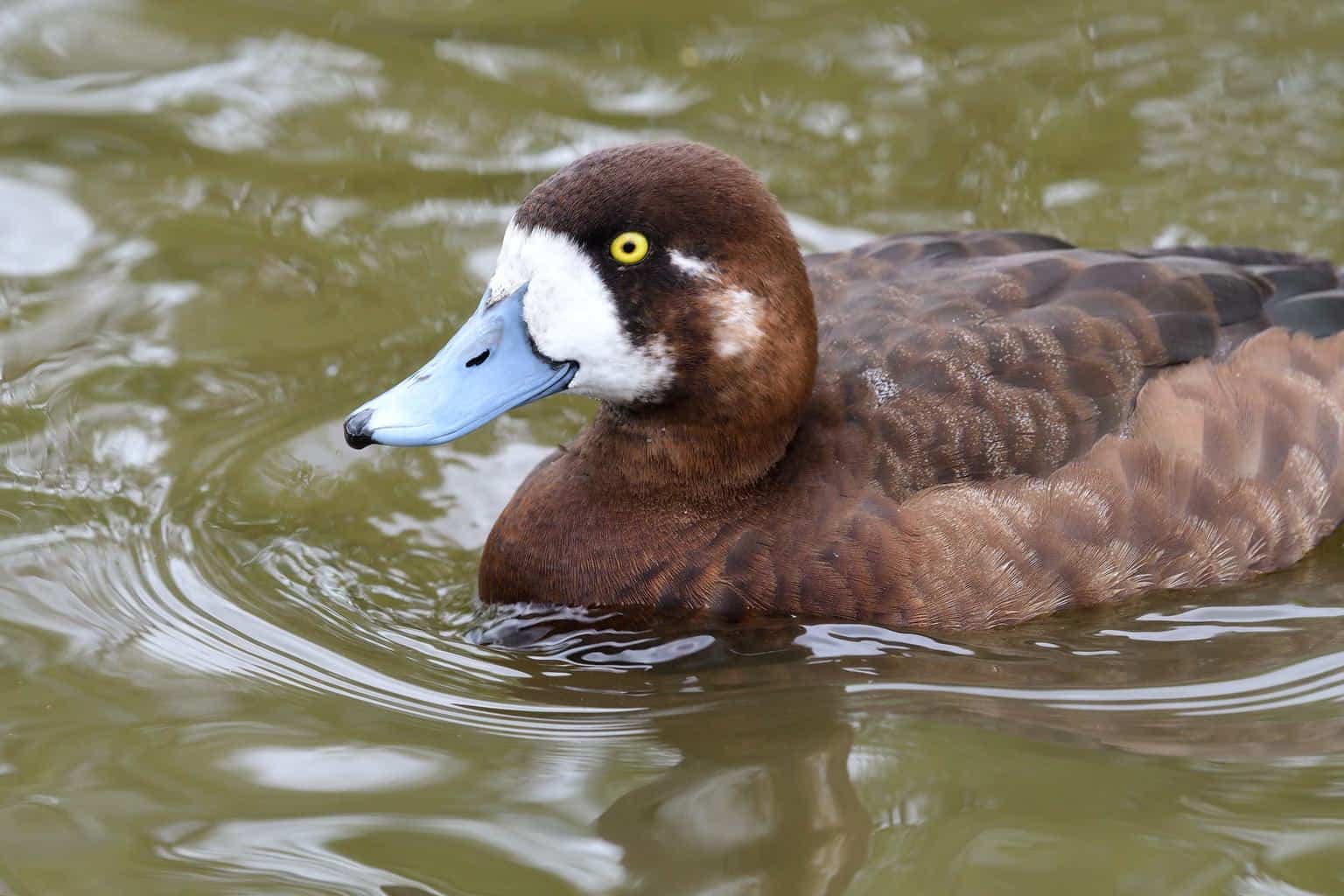
- Aythya marila
- Length: 15-22 inches
- Weight: 1.5-2.9 pounds
- Wingspan: 28-33 inches
There are two kinds of Scaup in Vermont: Greater and Lesser. Both are called Bluebills, thanks to their broad, slate-blue bill.
Greater Scaup migrate through Vermont in between their summer and winter territories. Some will stay throughout the winter, although they are more likely to make their way to their traditional winter territory, which includes North Carolina, South Carolina, parts of Oklahoma and Arkansas, the northwestern US, and the Pacific Coast.
During the breeding season, the male Greater Scaup has a white body and a brown-and-black barred back. He has a metallic green head.
The female is light brown, but her head is much darker brown.
During the non-breeding season, males look like a hybrid of a female and a breeding male. In Vermont, you’ll probably see their winter appearance.
The easiest part of identifying a Greater Scaup is seeing how thick and broad its bill is! The silhouette of a Greater Scaup is very different from other ducks thanks to this bill.
Green-Winged Teal Duck (Dabbling Duck)
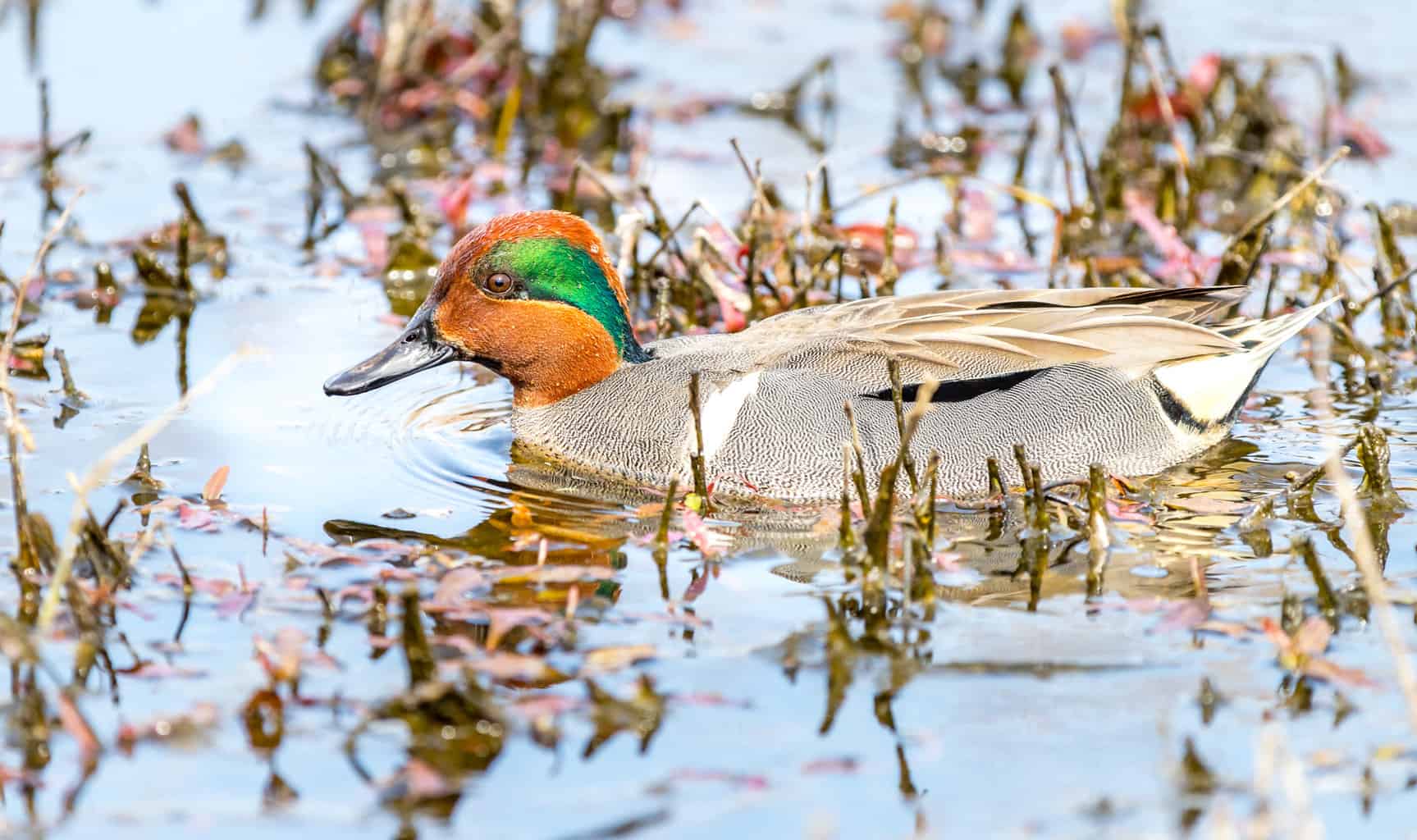
- Anas crecca
- Length: 12.2 – 15.3 in (31 – 39 cm)
- Weight: 4.9 – 17.6 oz (140 – 500 g)
- Wingspan: 20.5 – 23.2 in (52 – 59 cm)
The male Green-Winged Teal Duck has a green stripe that runs from his eyes along the back of his head. He is a small dabbling duck who is popular with duck hunters and birders alike.
Females are light brown, but they have a yellow streak running alongside their tails. The female has an iridescent green speculum, as does the male.
Green-Winged Teal Ducks are generally found in Vermont as they are migrating, but some stay put for the breeding season. If they’re migrating, you may see them in groups that number in the tens of thousands. More typically, they gather in much smaller groups of around 15 ducks.
One of the coolest attributes of the Green-Winged Teal Duck is its ability to take off in flight directly from the water, without needing to get a running start. They can easily transition from floating to flying, especially when they perceive a threat to their safety.
Harlequin Duck (Diving Duck)
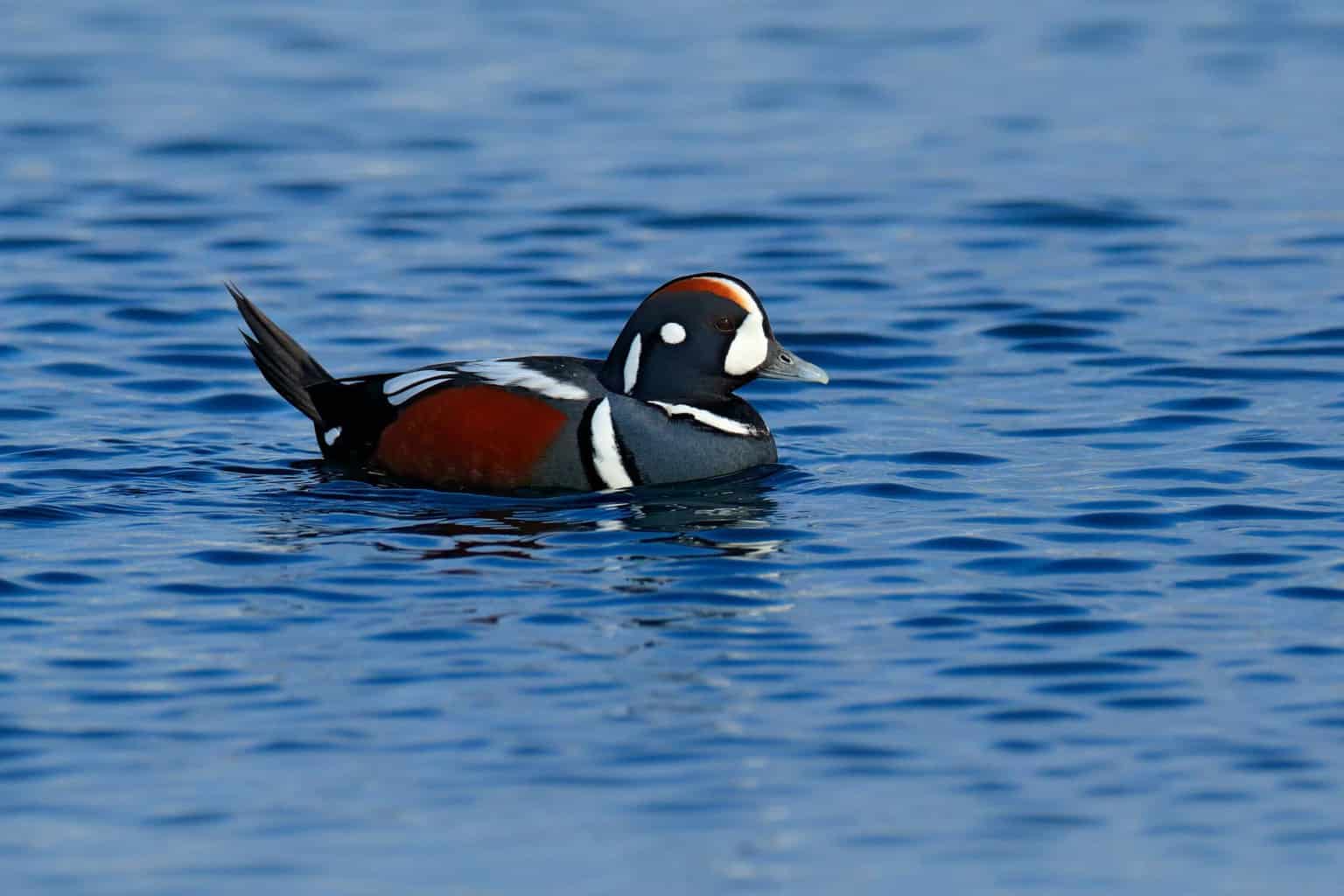
- Histrionicus histrionicus
- Length: 15 – 21 in (38 – 53 cm)
- Weight: 24 oz (680 g)
- Wingspan: 26 – 28 in (66 – 71 cm)
Harlequin Ducks are uncommon in Vermont, but they sometimes find their way to Lake Champlain in the winter. Their summer territory is split between far western and far eastern Canada, as well as parts of Greenland.
They are small diving ducks who make their home near dangerous ocean waves and craggy rocks. When they have been studied, researchers have found that Harlequin Ducks often suffer broken bones and skulls from being dashed against the rocks.
The male has dramatic coloring. During the breeding season, he is slate blue with black-outlined white stripes on his neck, chest, and head. He also has a large chestnut-brown area on his wings.
During the winter, when you’re more likely to see them in Vermont, males lose some of their vibrancy and look browner.
Females have dark brown bodies and small white patches on their faces and on the back of their heads.
Harlequins are nicknamed “the Sea Mouse” for the mouse-like sounds vocalizations they make.
Hooded Merganser (Diving Duck)
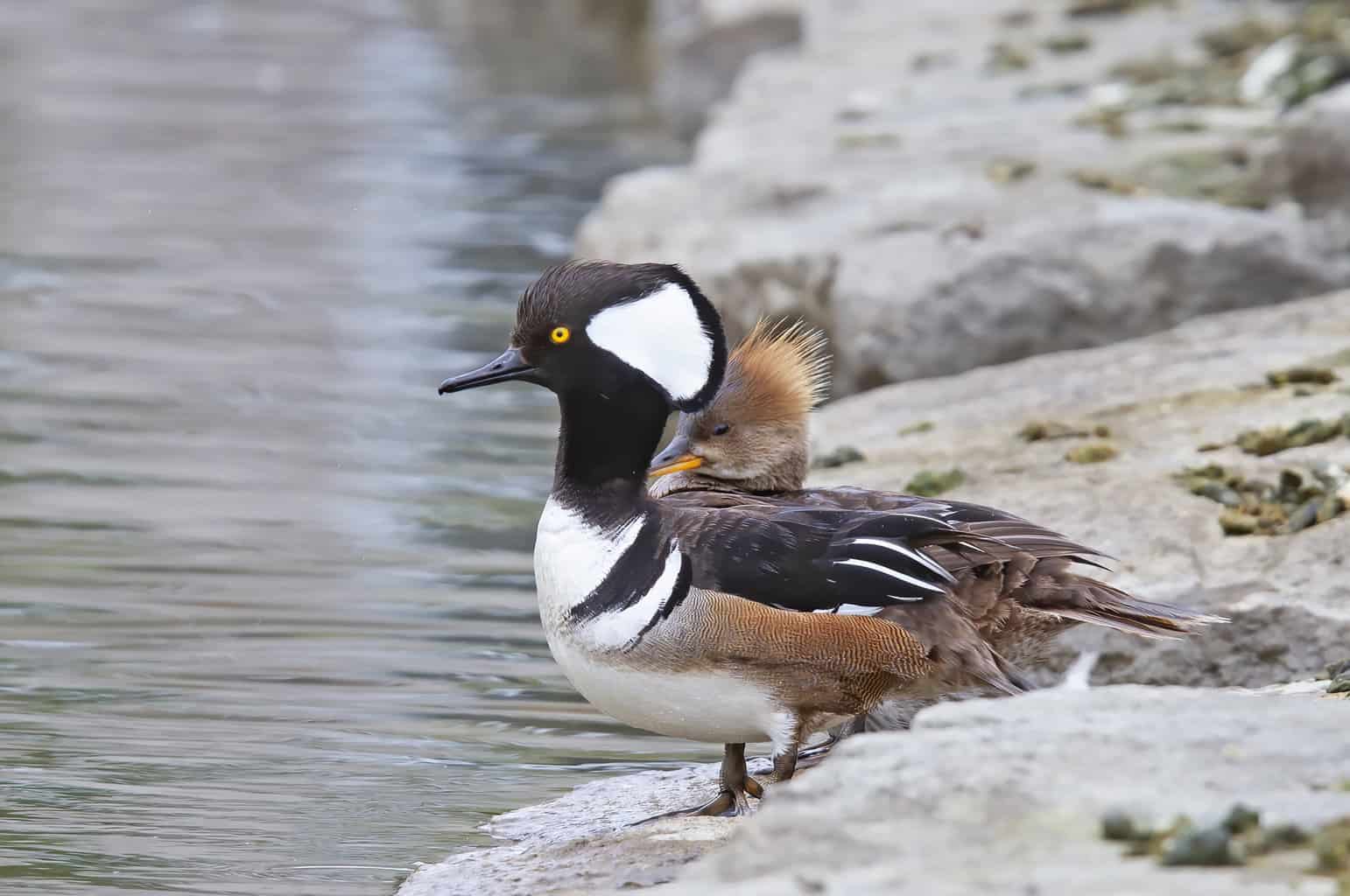
- Lophodytes cucullatus
- Length: 16 – 19 in (41 – 48 cm)
- Weight: 32.09 oz (909 g)
- Wingspan: 24 – 26 in (61 – 66 cm)
There are only a handful of ducks that can be found in Vermont year-round. One of them is the Hooded Merganser.
Hooded Mergansers in Vermont are evenly distributed throughout the state.
They aren’t particularly picky about habitat; they will live in a variety of settings. In the summer, they tend to breed and raise their broods along narrow creeks and rivers, or along the edges of small ponds.
In the winter, they enjoy ponds, swamps, and estuaries.
All Hooded Mergansers have a crest that they can lower or raise. The male’s crest is black and white and is shaped like a fan when it is extended. His sides are light brown, and his body is black and white.
Females have a cinnamon-brown crest that is shaggy, just like the Common Merganser female. She has very few markings on her body.
Hooded Mergansers are nicknamed “frog duck,” as they make a unique vocalization during the breeding season that sounds like a croaking pickerel frog.
Lesser Scaup (Diving Duck)
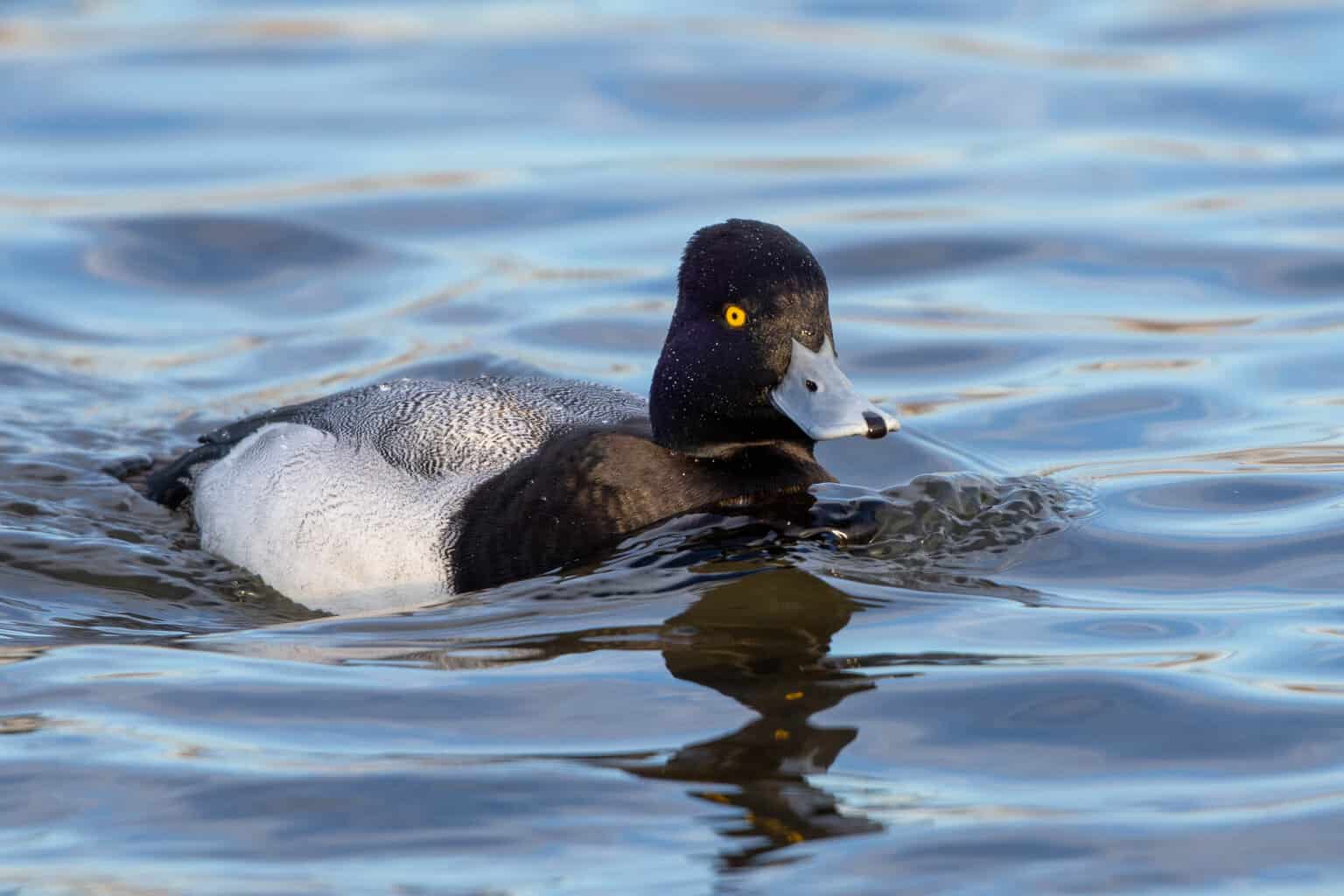
- Aythya affinis
- Length: 15 – 18 in (38 – 49 cm)
- Weight: 40.77 oz (1155 g)
- Wingspan: 24 – 33 in (61 – 84 cm)
It can be difficult to quickly differentiate between the Lesser and Greater Scaup. In Vermont, Lesser Scaup are winter residents along the western edge of the state. They may be seen elsewhere in the state as they migrate.
Lesser Scaup have an unusual trait for a duck: they have a few stray hairs at the top of their head. It creates just the smallest little crest, and Greater Scaup lack this feature.
The male’s head is iridescent purple (black from a distance), and his body is barred in gray and white stripes.
Females are dark brown, but you can look for the white patch on their faces to identify them.
Lesser Scaup are among the ducks that will play dead to trick predators. Camouflage is another defense mechanism. They also spend the winter in huge groups on large lakes.
Long-Tailed Duck (Diving Duck)
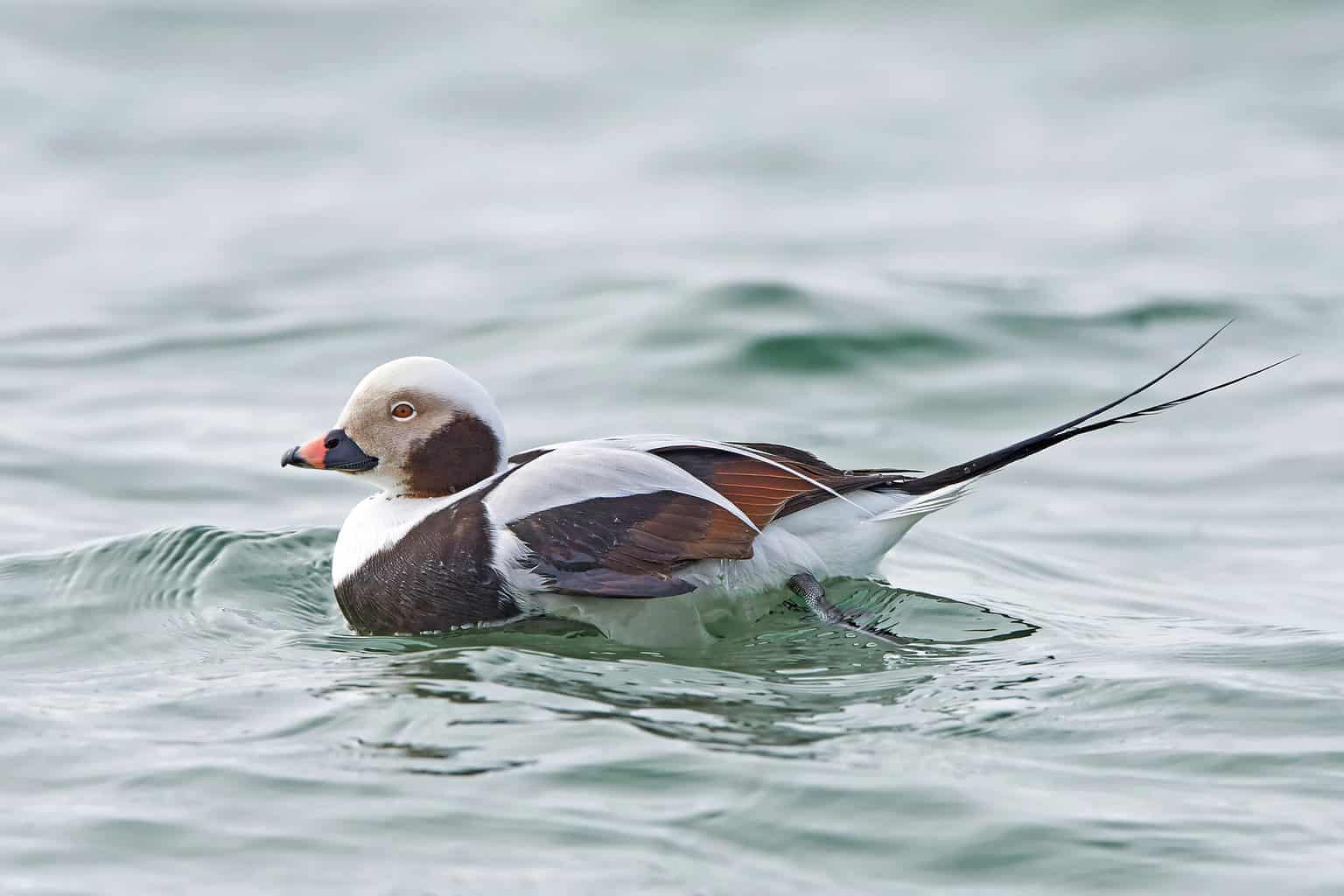
- Clangula hyemalis
- Length: 15 – 22 in (38 – 56 cm)
- Weight: 31.74 oz (900 g)
- Wingspan: 26 – 31 in (66 – 79 cm)
Long-Tailed Ducks do something truly unique among North American ducks: they reverse their colors between breeding season and winter!
Plenty of ducks change their appearance from one season to the next, but that usually involves losing some vibrancy or specific markings. Long-Tailed Ducks start out black and white, and then their black feathers are replaced by white feathers, and their white feathers are replaced by black ones!
In the winter, the Long-Tailed Duck is primarily white (crown, forehead, neck, back, and belly) with a gray mask and a dark black cheek patch, breast, and wings. He has white shoulders and a long black tail, which is what gives him his name.
In the summer, all of those white areas become black, and all of the black areas become white. It’s a fascinating transition!
Females do the same thing, too. In the winter, females are mostly brown with a white head. In the summer, their head is brown and their body is mostly white.
There are plenty of ducks whose appearance changes between the breeding and non-breeding season, but Long-Tailed Ducks may be the only ones whose colors literally reverse themselves between the seasons!
In the winter, the male Long-Tailed Duck has a lot of white on its body: the crown, forehead, neck, back, sides, and underside. He has a gray mask across his eyes and a dark black cheek patch, as well as a black breast and wings. His shoulders are white, and he has a long black tail (hence the name!).
Then, come summer, those colors switch. Any part of the duck that was black is now white, and the part that was white is now black. What an unusual and fascinating trait!
It’s not just the male who reverses his coloring. During the non-breeding season, females have a lot of brown on their bodies: throat, back, wings, and tail. Their head is white and they have a dark cheek patch. Then, come the breeding season, everything switches again, just like the male.
They are most likely to be seen in Vermont during the winter or during the migration season. Their preferred breeding territory is in the tundra of Canada, but they migrate south to the northern edge of the US for the winter.
They are deep-diving ducks who can submerge themselves up to 200 feet to catch their main staple: zooplankton.
Mallard (Dabbling Duck)
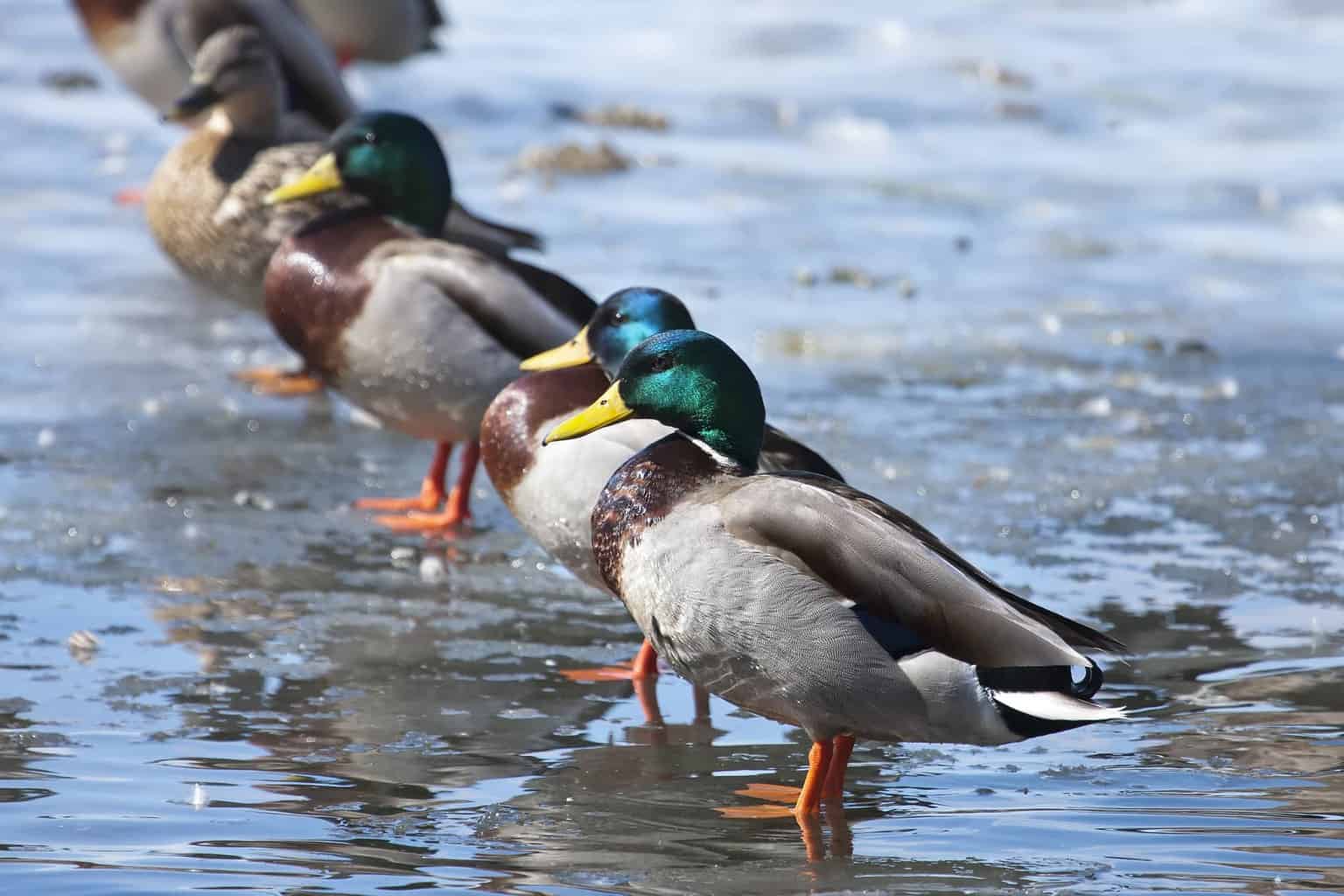
- Anas platyrhynchos
- Length: 19.7 – 25.6 in (50 – 65 cm)
- Weight: 35.3 – 45.9 oz (1000 – 1300 g)
- Wingspan: 32.3 – 37.4 in (82 – 95 cm)
Male Mallards are almost immediately recognizable. They have an iridescent green head with a bright yellow bill. They are gray-bodied with a brown breast and a pale blue speculum.
Female Mallards have a streaked and speckled brown body with a light brown head. Both males and females are easily identified by birders, hunters, and even children. They are often featured in duck-themed art and home decor – and even trendy Squishmallows for kids!
- Squeeze, cuddle, repeat! Squishmallows are the softest, cutest plush toys around!
- Your new cuddle buddy awaits! Meet Avery the Mallard! Squishmallows have a style and personality all their own, encouraging fun...
- Snuggle up with the squishiest friend in town! These super soft, collectible plush toys make great cuddle companions! The squishy...
Last update on 2024-07-26 / Affiliate links / Images from Amazon Product Advertising API
Mallards are also incredibly common throughout North America. They are the most common duck in both the US and Vermont.
They are incredibly territorial, aggressive ducks. Some people are troubled by the males’ sexually aggressive behavior toward females, but it’s good to remember that ducks aren’t making moral or immoral choices with their behaviors.
They are simply doing what they are genetically predisposed to do.
Northern Pintail (Dabbling Duck)
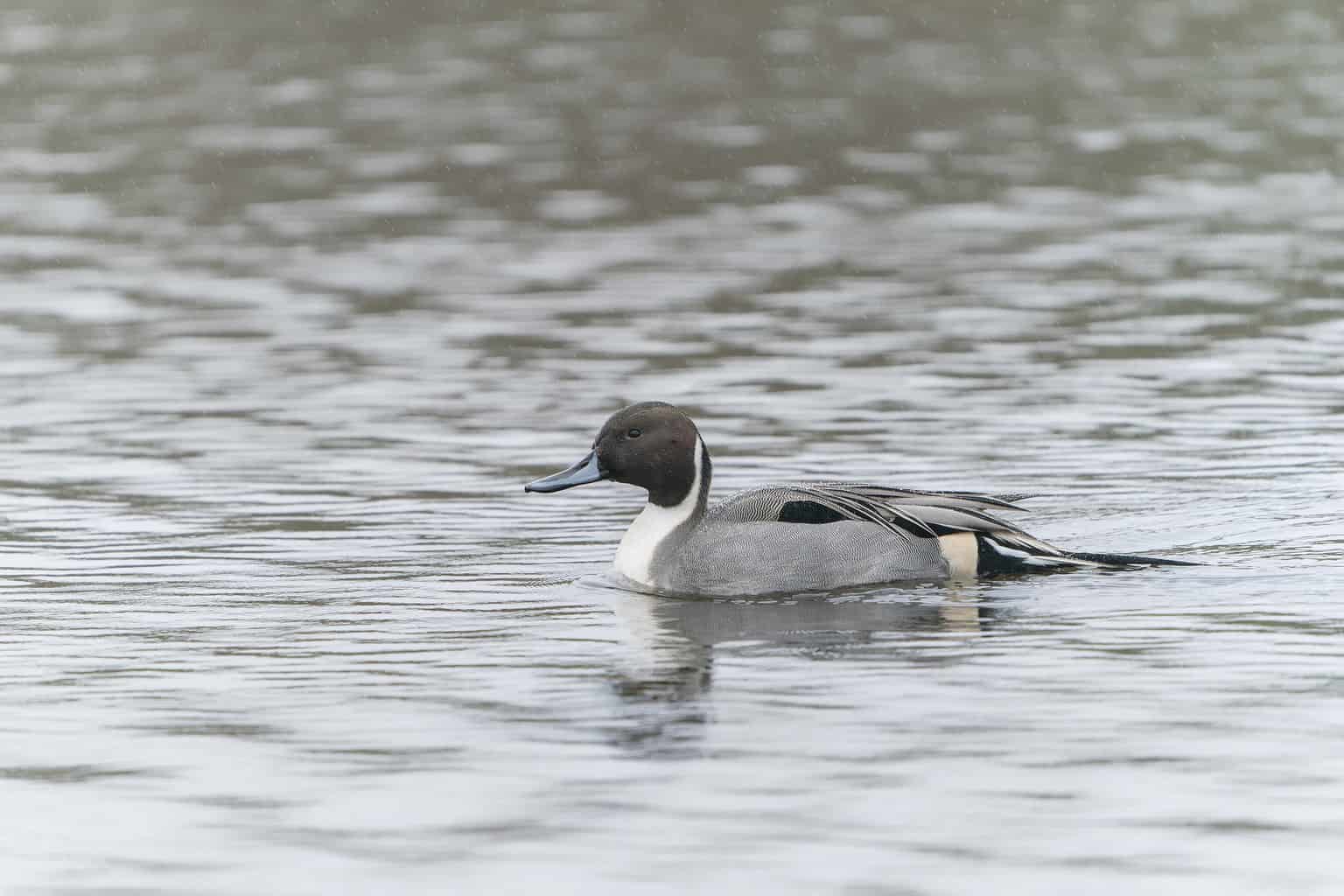
- Anas acuta
- Length: 20 – 26 in (51 – 66 cm)
- Weight: 36.33 oz (1030 g)
- Wingspan: 29 – 35 in (74 – 89 cm)
If you spot a male Northern Pintail in the summer, it’s easy to know where he gets his name: he has several long, pointed tailfeathers that fall off by winter.
Because these are winter residents in Vermont, you likely won’t see those very long tail feathers, but he still has a pretty pointy tail nonetheless. The male’s head is brown, and he has a white stripe on his neck. The rest of his body is gray, white, and black, and his speculum is green.
Female Northern Pintails have pointed tails as well; they are just not as long as the males’. Females are intricately patterned with a dark brown scaly appearance over most of their body.
They are incredibly fast ducks, flying up to 48 miles per hour, which makes them popular with hunters.
The Northern Pintail is a dabbling duck, so it doesn’t submerge itself underwater, but it can handle deeper waters because it has a much longer neck than the average duck.
It can reach further beneath the surface to get food: seeds, grains, crustaceans, snails, worms, and aquatic insects.
Northern Shoveler (Dabbling Duck)

- Spatula clypeata
- Length: 17.3 – 20.1 in (44 – 51 cm)
- Weight: 14.1 – 28.9 oz (400 – 820 g)
- Wingspan: 27.2 – 33.1 in (69 – 84 cm)
Even though Northern Shovelers and Mallards both have dark, iridescent green heads, it’s easy to tell them apart because of their bill.
Northern Shovelers have a thick, broad, “spatula-shaped” bill that they use to shovel up water. Then, they use their teeth to strain the water out of their bill and keep any plants and aquatic prey they caught.
The female’s bill is orangeish-brown, and the male’s is black. They stick to shallow, still waters and avoid rivers and the ocean.
They are uncommon visitors in Vermont who are usually only spotted during their migration season.
You won’t see this happen in Vermont because they don’t raise their young here, but this is an interesting trait nonetheless: Northern Shovelers are, like other ducks, prone to defecating on their own eggs. Their nests are often smelly and gross because their goal is to make their eggs less desirable to predators.
They are especially likely to do this when they feel threatened or startled by a predator or a perceived predator.
Red-Breasted Merganser (Diving Duck)
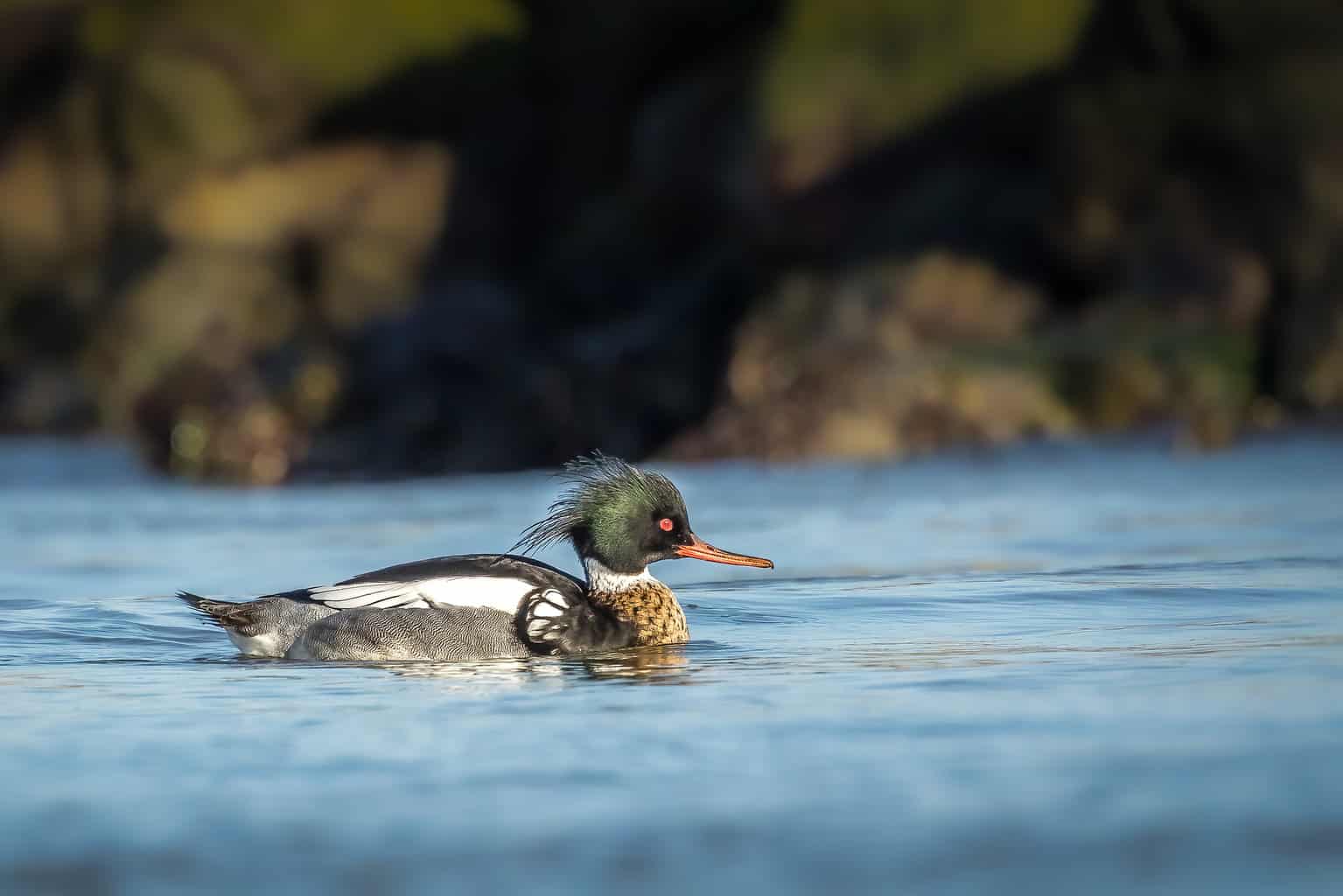
- Mergus serrator
- Length: 16 – 26 in (41 – 66 cm)
- Weight: 47.61 oz (1349 g)
- Wingspan: 31 – 35 in (79 – 89 cm)
The Red-Breasted Merganser, like other Mergansers, has an easy-to-spot shaggy crest.
The male has a dark green head, red eyes, a white neck ring, and a thin, orange sawbill. He will reach sexual maturity and full breeding colors when he turns 2 years old.
The female has a cinnamon-brown crest, as well as a shaggy crest like the male. She has a gray body and a white throat. Her eyes are red. Her bill is like his: thin, orange, and serrated.
Red-Breasted Mergansers live in Canada’s coniferous forests during their breeding season and migrate through southern Canada and all of the US to get to their coastal winter habitats along the Pacific, Atlantic, and Gulf coasts.
They are primarily migratory visitors to Vermont, but some will stay here in the winter.
Redhead (Diving Duck)
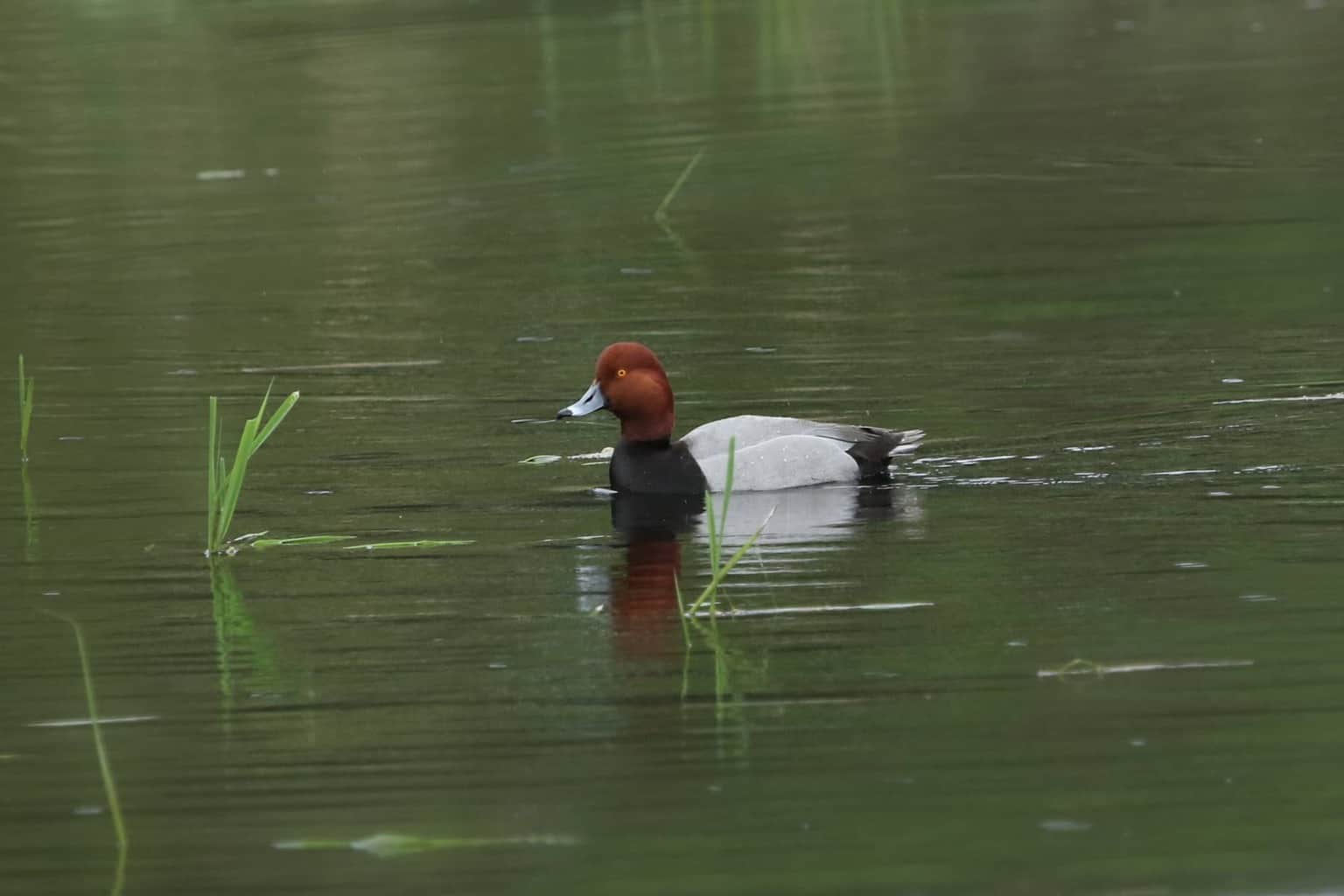
- Aythya americana
- Length: 18 -22 in (46 – 56 cm)
- Weight: 43.03 oz (1219 g)
- Wingspan: 29 – 35 in (74 – 89 cm)
The male Redhead has a dark coppery-brown head, a dark gray bill with a black tip, and a gray and black body.
The female has relatively unremarkable markings on her brown-all-over body, but she does have the same black-tipped bill as the male.
Redheads tend to travel to the Gulf of Mexico for the winter, but they are occasionally long-term winter residents in Vermont. They are considered rare in the state.
Redheads are brood parasites, which means that they may lay their eggs in other ducks’ nests. They are not exclusively parasitic like the Brown-Headed Cowbird, which doesn’t even build its own nest. Instead, they lay some eggs in their own nest and sometimes lay eggs in other Redhead’s nests.
This is a practice that increases the success of Redhead ducks’ survival. If something happens to one Redhead’s nest, perhaps her other ducklings will survive and thrive.
Ring-Necked Duck (Diving Duck)
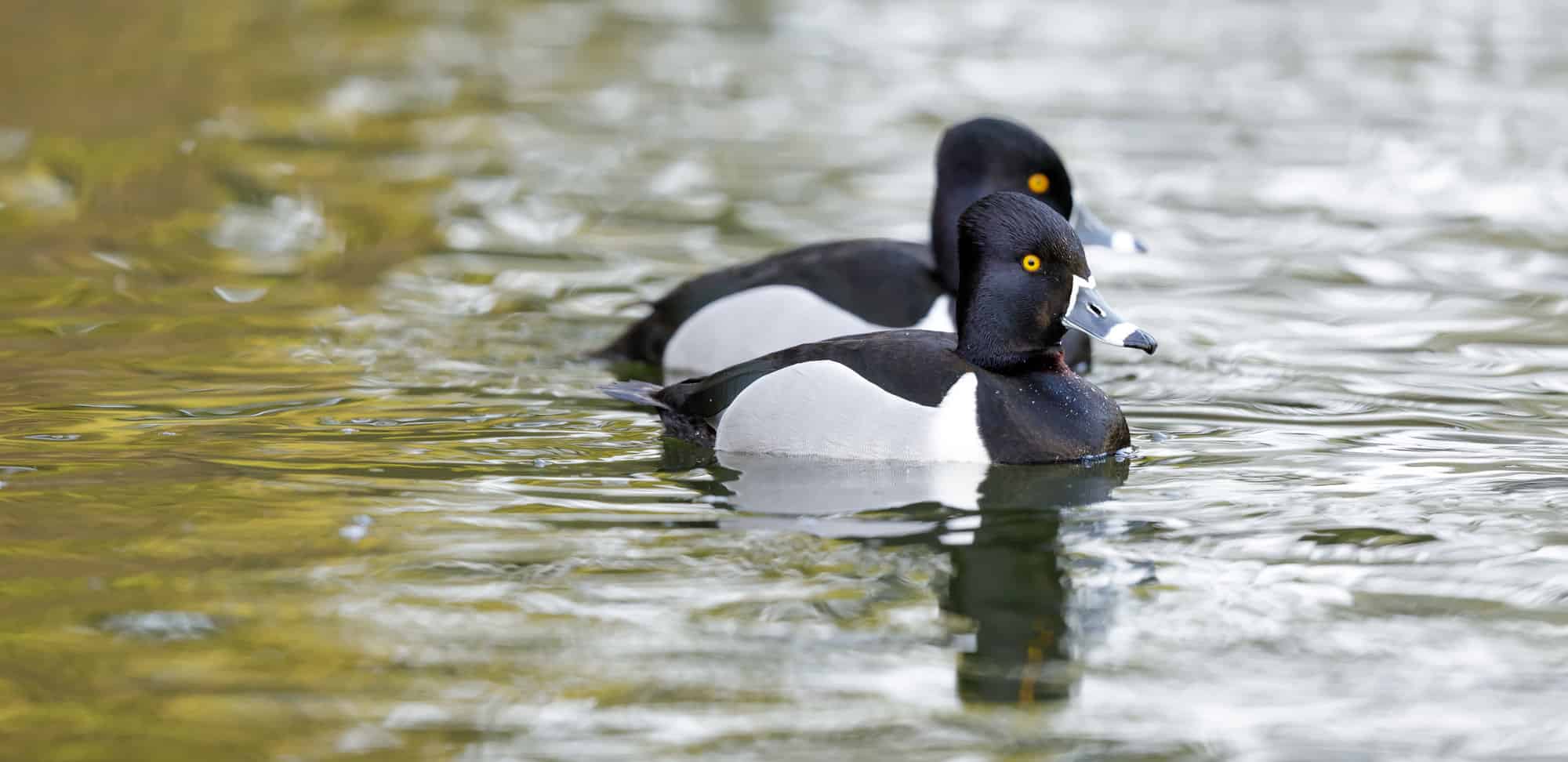
- Aythya collaris
- Length: 14 – 18 in (36 – 46 cm)
- Weight: 32.09 oz (909 g)
- Wingspan: 24 – 30 in (61 – 76 cm)
Ring-Necked Ducks breed in northern Vermont and migrate through the rest of the state when it’s time to head south.
They do not, in fact, have a noticeable ring around their neck, but the males have a ring around the base of their bill and a white band around the tip. Why are they called “Ring-Necked,” then?
Upon very close inspection, you may be able to see a subtle, almost undetectable copper ring around their neck. For some reason, this feature stood out to the naturalists in the 1800s who gave the duck its name.
Perhaps it was more noticeable on the duck carcasses they were examining in the lab, rather than out in nature.
The male Ring-Necked Duck has a black chest, back, and head. His belly is white.
The female is brown with a gray face and eyes outlined in white. She also has a white stripe around her bill, but she does not have the ring around the base of her bill that the male has.
Ruddy Duck (Diving Duck)
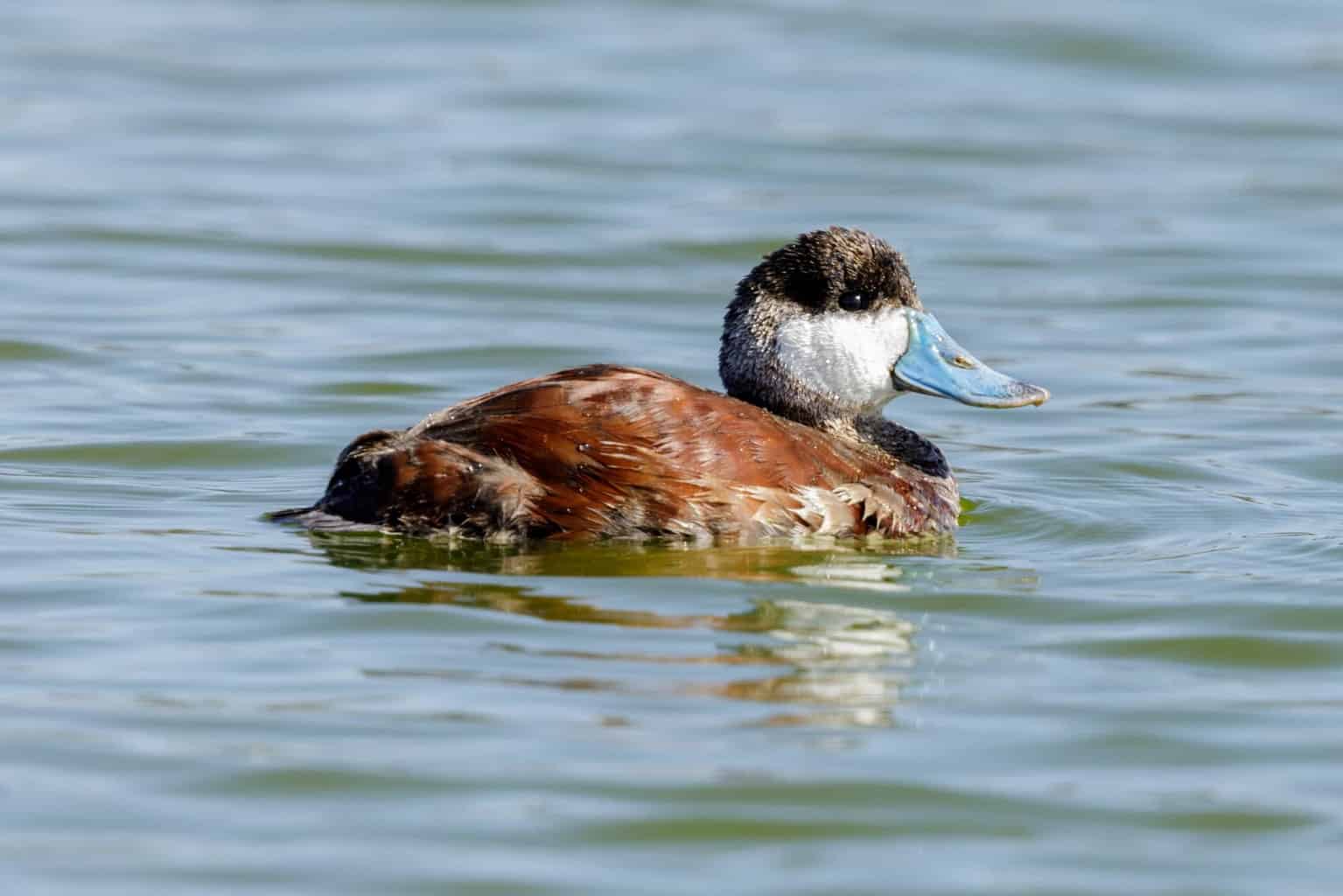
- Oxyura jamaicensis
- Length: 14 – 16 in (35.56 – 40.64 cm)
- Weight: 28.04 oz (795 g)
- Wingspan: 21 – 24 in (53 – 61 cm)
During the breeding season, from May to August, male Ruddy Ducks are dark brown. The rest of the year, they are dull gray. Males are black-capped and have a large white patch on their cheeks. His broad bill is sky blue.
The female Ruddy Duck is stippled in shades of brown. She has a gray cheek patch and a black bill.
Ruddy Ducks migrate through Vermont. In the fall, you may see them in their more vibrant colors, as they probably haven’t molted yet.
In the spring, when they head to the western half of the US and Canada to breed, they likely haven’t adopted their breeding season colors yet.
Some female Ruddy Ducks will lay an egg in another duck’s nest, but for the most part, they hatch and raise their own young.
Surf Scoter (Diving Duck)
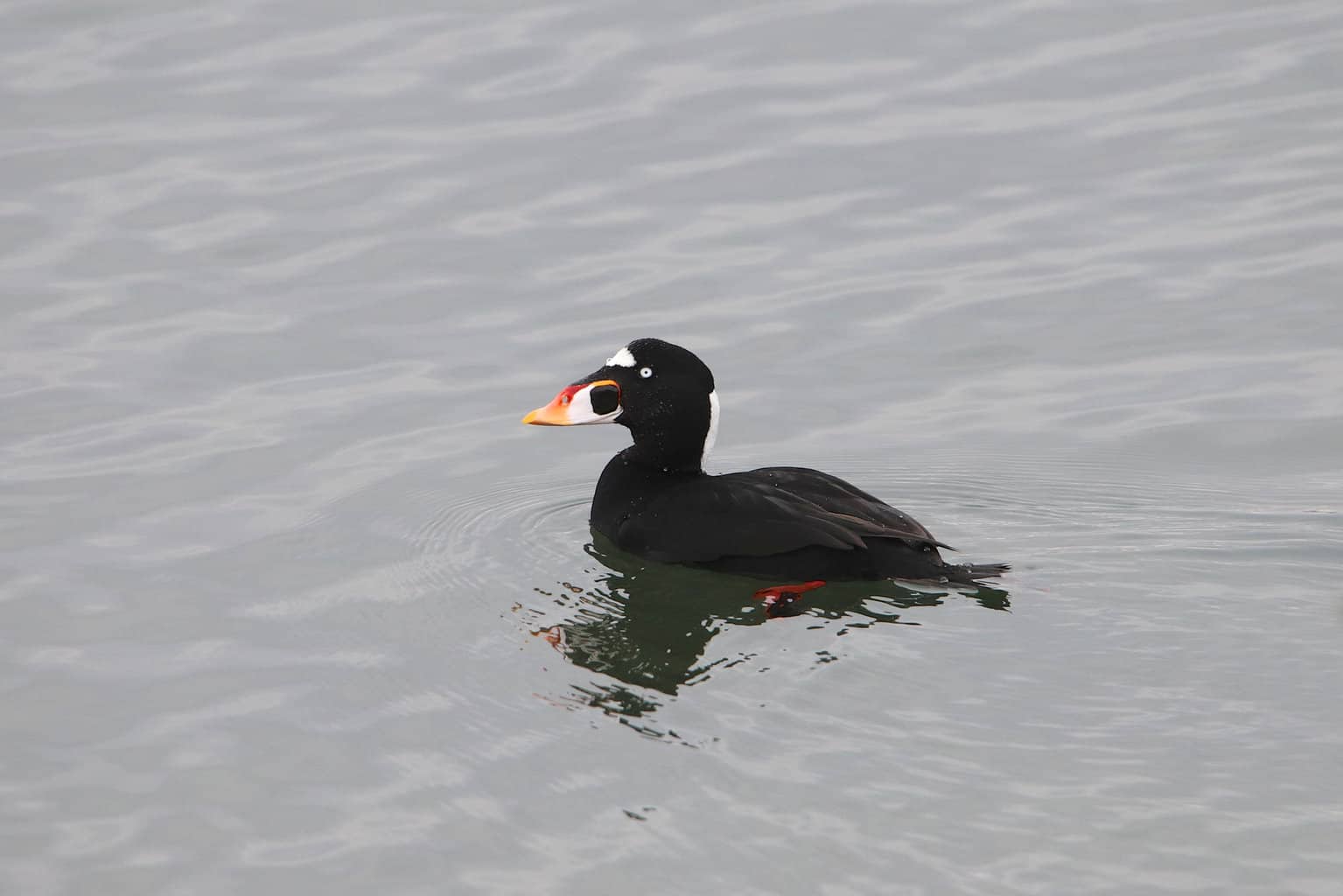
- Melanitta perspicillata
- Length: 17 – 21 in (43 – 53 cm)
- Weight: 35.27 oz (1000 g)
- Wingspan: 30 – 36 in (76 – 91 cm)
The coolest thing about a Surf Scoter’s appearance is its tall, thick bill. This unique bill is also the key to identifying these large diving ducks.
Both females and males have the same large bill that slopes dramatically from the forehead. In males, it is orange, red, and yellow. In females, it is dark gray and just a bit smaller.
The male’s body is black, but he has two white spots: one above his bill and one on the back of the neck. The female is dark gray with a white patch on the back of her neck. Instead of a white patch above her bill, she has one behind her eyes.
Surf Scoters tend to spend the winter on the Atlantic Coast of New England, but they sometimes spend the winter in Vermont, too. Their diet consists of freshwater crustaceans, fish, worms, and aquatic insects.
White-Winged Scoter (Diving Duck)
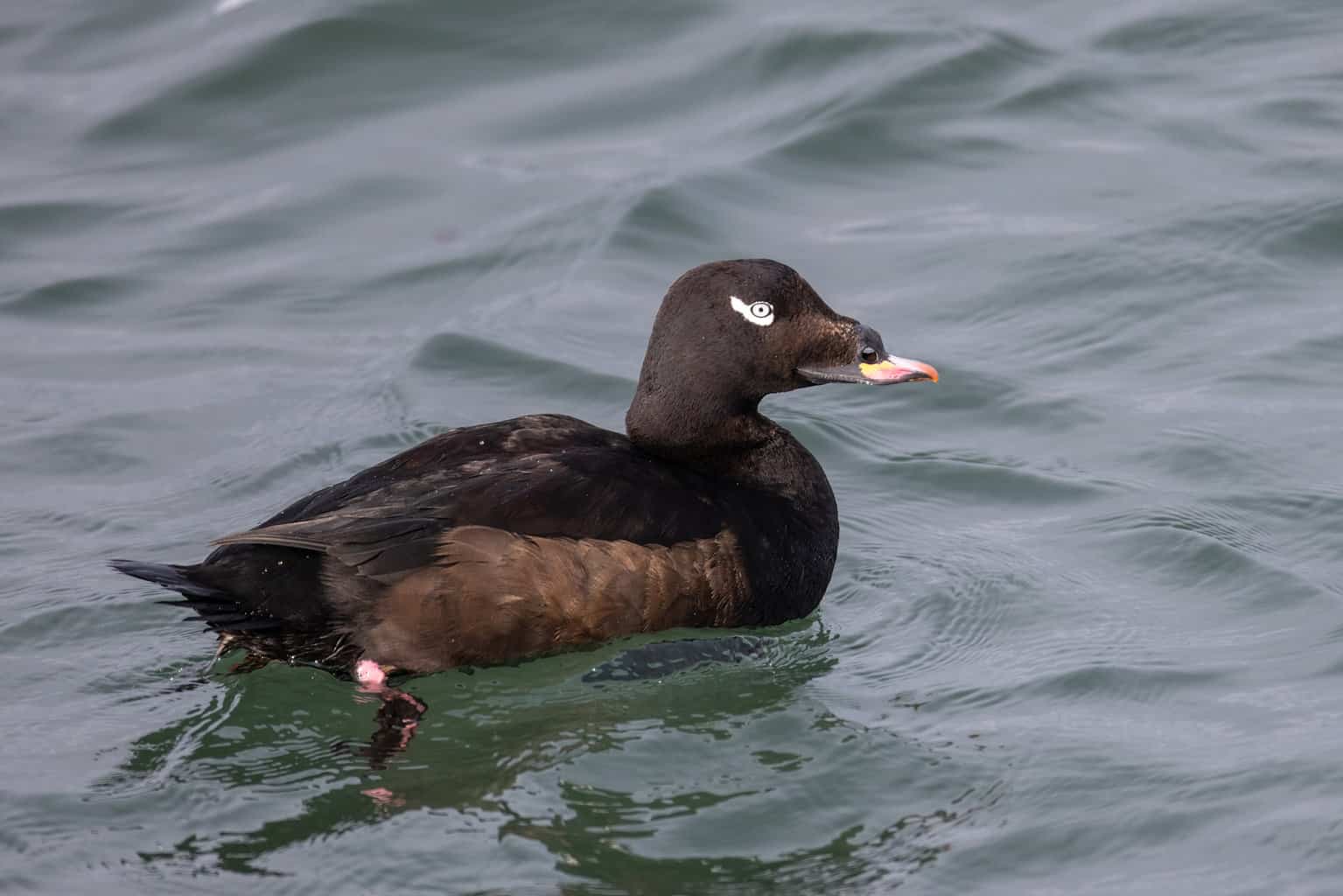
- Melanitta deglandi
- Length: 19 – 24 in (48 – 61 cm)
- Weight: 62.4 oz (1768 g)
- Wingspan: 33 – 41 in (84 – 104 cm)
White-Winged Scoters are, like other scoters, identifiable by their bulky bill that has what looks like a knob at its base.
Males and females are very similar in appearance, which makes it easier to spot a scoter but harder to differentiate between sexes.
For the White-Winged Scoter male, watch for a dark black duck with a white “reverse comma” pattern over his eyes. His wings have a long, white stripe that you can see while he’s sitting or swimming.
For the female, look for a very dark brown duck with some white on her wings and a small white cheek patch.
White-Winged Scoters will either migrate through Vermont or stick around for the winter. Their primary breeding ground is Western Canada and Alaska, and they tend to winter along the Pacific and Atlantic coasts (interestingly, they tend to avoid Florida.).
When they live in Vermont, they had back to the same area where they were hatched, as White-Winged Scoters practice natal philopatry.
Wood Duck (Dabbling Duck)
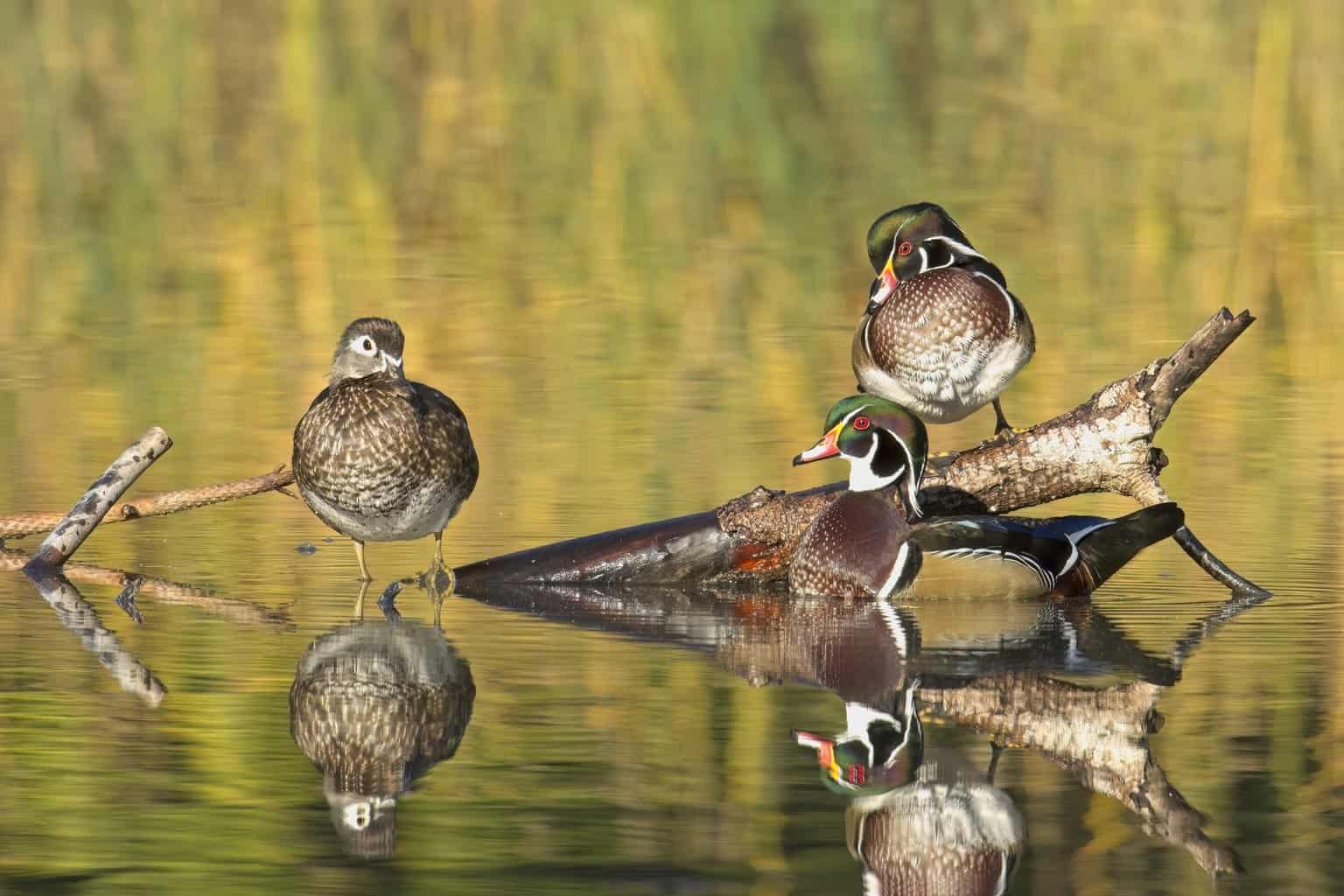
- Aix sponsa
- Length: 18.5 – 21.3 in (47 – 54 cm)
- Weight: 16.0 – 30.4 oz (454 – 862 g)
- Wingspan: 26.0 – 28.7 in (66 – 73 cm)
The last duck on our list, the Wood Duck, is truly beautiful.
Wood Ducks are very common in Vermont. Some Wood Ducks will stay all year, but for the most part, they are winter ducks who are here between March and October.
The male Wood Duck has a stunning iridescent green head with a long crest at the base. His sides are buff and his breast is chestnut-brown with cream-colored stippling. He has white markings all over his body, and the complex pattern of his bill includes red, orange, white, and black.
He has breathtaking red eyes, too.
Females are brown-bodied with gray heads. She has a blue speculum, a small crest at the back of her head, and a white rim around her eyes.
Wood Ducks have shimmering, iridescent green heads that look a bit like a Mallard’s head. One big difference is the long crest at the base of the head.
Wood Ducks nest in tree cavities up to 60 feet above the ground. They live very close to the water, though, typically only feet away from rivers, wetlands, ponds, and swamps.
Their main diet includes a lot of seeds and nuts, as well as aquatic plants and some living creatures: insects, tadpoles, and salamanders.
The female Wood Duck does something unlike any other North American duck: she lays eggs twice a year. By raising two different clutches of eggs, she increases her chances of passing on her genes to future generations.
The Final Word – Ducks in Vermont
It’s really no surprise that there are so many fascinating ducks in Vermont. With so many other birds and such incredible wildlife in the state, it only makes sense that there would be a lot of ducks here, too.
Check out our Bird Guide for Vermont to learn more about the variety of birds that make their home in the Green Mountain State.
They may be here for the whole year, a few months, or just a few days as they migrate, but we have so many interesting species to find and identify.
If you make your way to some of the more remote waters, you might want to take along some essential gear like spotting scopes, tripods, binoculars, and a notebook to keep track of all the ducks you see.
Whether you are a permanent resident of Vermont or you’re just traveling through, start watching the waterways, ponds, lakes, and wetlands.
You’re bound to start seeing fascinating ducks all over the place!

